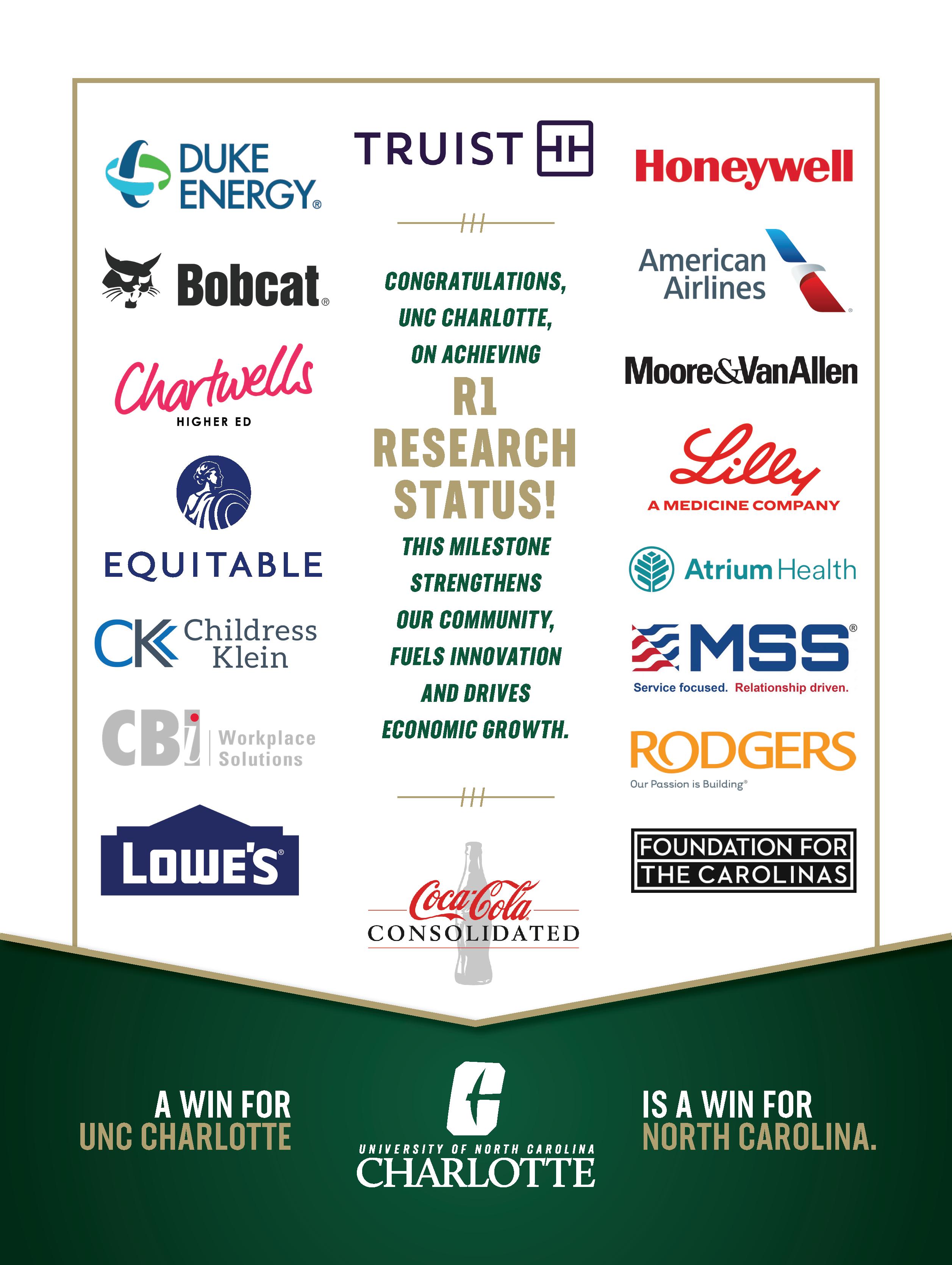







4 UPFRONT
6 POWER LIST INTERVIEW
Economic development leader Christopher Chung discusses how North Carolina aims to remain the envy of its peers.
A Greenville gaming entrepreneur cashes in; Duke Health picks up its pace; A fourth-generation CEO steps up at Carolina Cat; It may be Bad Company’s time; Turning a party into a business; Stephen Curry plots a Davidson rebound.
Baseball’s storied history in the Tar Heel state takes a corporate turn with investment groups taking unprecedented stakes in teams and stadiums, with support from local governments and taxpayers.
BY TUCKER MITCHELL

32 COMMUNITY CLOSE-UP: BRUNSWICK, NEW HANOVER, PENDER
People arriving at these three southeastern counties are finding vibrant communities filled with new opportunities.
42 ROUND TABLE: TRANSPORTATION
Six experts discuss planes, trains, automobiles, trucks and ports and the strategies to keep North Carolina moving.
80 INDUSTRIAL PARKS
Years of effective local planning have allowed communities to reinvent themselves and offer space for commercial growth.


A pending deal has Jose Costa and Whistle Express poised to be the captains of car washing.
BY DAVID MILDENBERG
The world’s best golfers head to Charlotte ; The N.C. Golf Panel presents the state’s best courses; Hurricane Helene’s toll. BY BRAD KING, TRENT BOUTS
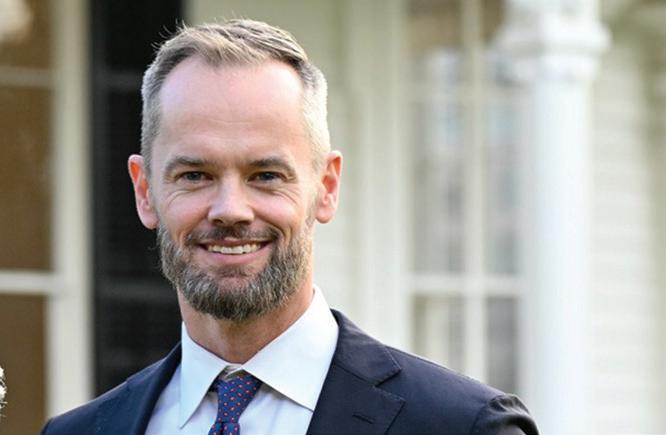
The state’s new Commerce secretary brings rural roots, lobbying experience and bipartisan instincts.
BY RAY GRONBERG

It strikes me that change is inevitable and that North Carolina is getting better all the time. It’s easy to long for the good old days, even if they weren’t all that good, while appreciating enduring values that make for long-term progress.
The thought, and more specifically how Raleigh has changed, was sparked by a chat with Brad Hurley, who with John Vick has run the 42nd Street Oyster Bar restaurant in downtown Raleigh since 1987. They succeeded partner Thad Eure Jr., who envisioned the addition to his hugely successful Angus Barn in west Raleigh. Sadly, he died of pancreatic cancer at age 56 a year after the Oyster Bar’s debut.
The restaurant is famous as the site where many key decisions were hammered out by lobbyists, politicians and Raleigh influencers. An iconic mural at the restaurant shows former Gov. Bob Scott; Eure’s father Thad Sr., who was N.C. secretary of state for 52 years; 36-year Agriculture Commissioner Jim Graham and developer Willie York, who created the Cameron Village shopping center.
“People have said the big, bad landlord wins again, but that isn’t right,” Hurley says. “We had a good run and we chose not to sell the restaurant.”
Yes, change is inevitable and often positive when insightful folks are steering the ship. Many examples of changemakers are evident in this edition.
Christopher Chung’s name pops up a lot this month. State leaders recruited him from Missouri a decade ago to lead the state’s industry recruitment. He’s handled the pressure with aplomb, letting the politicians strut while gaining the confidence of both sides in a highly partisan environment.

Hurley is an East Carolina University grad who in the 1970s joined the upstart Darryl’s chain, formed by the younger Eure and Charlie Winston. He learned the spirits business at the company’s Lexington, Kentucky, restaurant, in preparation for the legalization of mixed drinks in parts of the state in 1978. Darryl’s sent bar trainers from Kentucky to its N.C. restaurants, which benefited from liquor by the drink.
Eure saw the opportunity for a classy, clubby watering hole near the state Capitol when lobbyists could buy dinners and drinks with limited oversight. At its peak, the 240-seat restaurant employed 120 people.
T hirty-eight years later, Hurley and Vick are in their 70s and not ready to commit to another lease with the longtime property owners, the Hobby family. A late March closing was planned. Hurley and Vick didn't want to see the restaurant's reputation decline. While there’s more competition for diners now, the restaurant is doing fine, he says.
Charlotte kingpin Johnny Harris gets a mention in our section focusing on the state’s golf business. His longstanding promotion of the sport's economic impact in North Carolina has led to global broadcasts of Charlotte’s major golf tournaments. That’s made the Queen City more inviting to CEOs, whose relocation decisions have changed the state. Bobby Long in Greensboro and Robert Dedman and Tom Pashley in Pinehurst have played similar roles with their events.
In the Statewide report, we note Kevin Howell’s selection as chancellor at NC State University in May. He has to sustain momentum from Randy Woodson’s 15-year tenure at the campus. Lacking the Ph.D. pedigree of most university chiefs, Howell is among the state’s most well-liked leaders after two decades of key roles at the Raleigh campus and UNC System.
Vision also can lead to personal fortune. Gambling industry entrepreneur Garrett Blackwelder hit the jackpot in February, selling about half of his Greenville-based Grover Gaming for $1 billion. (See Page 8.) Perhaps more effectively than anyone in state history, he figured out how to tap into the insatiable national obsession for betting.
That vision thing is a pretty rare, unpredictable and amazing beast, don’t you think?

Contact David Mildenberg at dmildenberg@businessnc.com.

VOLUME 45, NO. 4
PUBLISHER
Ben Kinney bkinney@businessnc.com
EDITOR
David Mildenberg dmildenberg@businessnc.com
MANAGING EDITOR Kevin Ellis kellis@businessnc.com
ASSOCIATE EDITORS
Ray Gronberg rgronberg@businessnc.com
Cathy Martin cmartin@businessnc.com
EDITORIAL INTERN
Natalie Bradin
CONTRIBUTING WRITERS
Pete M. Anderson, Dan Barkin, Chris Burritt, Trent Bouts, Brad King, Tucker Mitchell
CREATIVE DIRECTOR
Cathy Swaney cswaney@businessnc.com
GRAPHIC DESIGNER
Lauren Ellis
M ARKETING COORDINATOR
Jennifer Ware jware@businessnc.com
EVENT DIRECTOR
Norwood Teague nteague@businessnc.com
ADVERTISING SALES
ACCOUNT DIRECTOR
Melanie Weaver Lynch, eastern N.C. 919-855-9380 mweaver@businessnc.com
ACCOUNT MANAGER
Anne Brundage, western N.C. abrundage@businessnc.com
CIRCULATION: 818-286-3106
EDITORIAL: 704-523-6987
REPRINTS: circulation@businessnc.com
OWNERS
Jack Andrews, Frank Daniels III, David Woronoff, in memoriam Frank Daniels Jr.
PUBLISHED BY Old North State Magazines LLC
PRESIDENT David Woronoff




Christopher Chung, CEO of the Economic Development Partnership of North Carolina, joined High Point University President Nido Qubein in the Power List interview, a partnership for discussions with influential leaders. The interview was edited for clarity.
Why did you major in Japanese?
In my formative younger years, Japan was really in economic ascendancy. You will remember in the 1980s, our automotive industry here in the United States and other industries in the country were worried about Japanese prominence, much in the same way that today we see that same concern about China.
I grew up in a suburb of Columbus, Ohio, that was home to a lot of Japanese family transplants who worked at the major
Christopher Chung defers to the politicians at ribbon cuttings, but insiders know he’s a key force in state industry recruitment after a decade leading the 70-employee Economic Development Partnership of North Carolina. The son of Taiwanese immigrants earned a dual-major bachelor’s degree in Japanese and economics at Ohio State University, then worked in industry hunting jobs in Ohio and Missouri before moving to Raleigh in 2015. EDPNC was started under the tenure of former Gov. Pat McCrory, a Republican who favored a split from the N.C. Department of Commerce. Since then, Chung has cultivated bipartisan support for the partnership, which works on deals before getting final financial approval from the state agency and elected officials. He and his wife, Emily, have two daughters.
Honda factory on the outskirts of Columbus. I got to know a lot of these kids personally, but also saw that there was probably a good professional reason long-term to study this language.
I developed an interest in the food and the culture, all those things that when you’re 11 or 12 years old, they might drive your interest in learning a new language.
My parents had quite a bit of exposure to Japanese culture because Japan governed Taiwan from about 1895 to the end of World War II.
It ended up being a great decision, personally, because it led me into the career path that I’m in right now.
The Economic Development Partnership of North Carolina is a vital, vibrant organization in our state. You have been a champion in attracting so much business to our state, highlighted by Toyota Battery, Boom Supersonic, Apple, and so on. What attracts people to the Tar Heel state?
The number one draw by far is the access to human capital. If you’re a company, whatever industry you are, you need people to be successful. It doesn’t matter if you’re in manufacturing or technology or life sciences, you depend on the access to that skilled talent to be the number one company in your particular industry.
When companies look here in North Carolina, they’re really floored by the workforce story, both in terms of what we’re producing through fine institutions like High Point University and all our private and public schools across the state, as well as our two-year community colleges.
We have a lot of people who are leaving military service from right here in North Carolina re-entering civilian life. And then add that people who continue to migrate in from the Northeast, the Midwest, California, other parts of the South.
We continue to be a magnet for people moving here who bring not only their educational abilities, but their skills, their experiences, their connections, and all of that creates a really attractive talent picture.
You and your staff have done a fantastic job in attracting something like 70,000 new jobs in our state, which, of course, contributes measurably to economic impact, tax base and housing starts. Do we have capacity to keep growing?
Well, I would rather be answering that question, than other states that may be wondering, “Well, what does it take to emulate the kind of success North Carolina has?”
I’ll be very clear. We are part of a broader team of partners doing this type of work all across the state that involve the public sector, the private sector, the nonprofit sector. We get to be the tip of the spear in a lot of these conversations with companies.
By no means does that credit fall solely to our organization. We have so many local, regional, private sector partners that we all call in when we get these opportunities.
But where is that equilibrium? At some point are we going to be taking jobs from this company, or do we really have a supply of workforce that we can promote?
That’s really going to be the key to North Carolina’s longterm, sustained success in economic development. Can we keep up with the challenges of growth? I think any state would much rather have to deal with the challenges of growth.
That’s where we depend on our state policymakers, and our local government officials, to make sure that we’re investing in things like educational capacity, infrastructure, housing availability.
If not properly managed, we might see growth start to have some really negative consequences.
But, yes, I believe that North Carolina will continue to have plenty of room to grow as long as we’re smart about planning our investments in the future so that that growth never becomes a liability or compromises the quality of life that has drawn people here for decades.
What do you mean by improved infrastructure? Does that mean highways, airports, ports?
One thing that people notice in a high-growth area can be traffic congestion. That starts to really erode into quality of life. Here in the Piedmont Triad region of Greensboro, Winston-Salem and High Point, the road system is very well planned and built out. There is a tremendous amount of excess highway capacity right now that really sets this region up well for the future. We want to make sure that continues to be the case in places like Charlotte, the Triangle, Asheville, Wilmington and other high-growth markets in the state.
We’ve also really seen in the past few years, across the whole country, as well as here in North Carolina, housing has gotten to be really expensive and really hard for people to get into.
If they’re not making a certain amount of money, they really have to look very far away, and commute a much greater distance to get to the jobs that are being created in the center parts of these growing markets.
These are challenges of growth. We’d much rather have them, but that doesn’t make them any easier of a challenge to try to address.
Sometimes we lose a deal, right? They go down to South Carolina and part of that is often money that some of these companies are looking for.
Much as I hate to admit it, yes, sometimes that does happen. Part of that is often money. As a state, we’ve made a lot more progress. I think roughly 10 years ago when I started in this role,
I would say incentives were much more of a frequent reason as to why we would lose, especially the really big transformative deals.
A deal like what Toyota is doing here in Greensboro, that would’ve been one we would be vulnerable to losing based on incentives a decade ago. We didn’t quite have the mindset that we had to be very, very competitive.
I would say that that’s come a long way because of the governor and the General Assembly working closely together to figure out how we incent these deals responsibly, but in a way that’s going to allow us to emerge tops in the competition.
Today, we actually lose deals much earlier in the process when we do lose, because we lack the kinds of industrial real estate necessary to attract some of these very large advanced manufacturing facilities.
Those parcels of land are getting increasingly in short supply, partly because we’ve been successful in filling those types of sites with major users.
We have to make sure that inventory doesn’t get so low that we start being unable to compete for a lot of these big projects.
What is your biggest challenge?
We want to make sure that when companies continue to look in North Carolina, we can answer their concerns about long-term workforce availability.
Talent is the big reason that we wore the crown for two years in a row for being the top state for business, according to CNBC. We want to make sure that from a workforce and talent standpoint, we continue to be the superlative choice across all 50 states.
That isn’t something that will just happen. That is my concern because it’s going to take very deliberate, intentional policy and strategy for us as a state to stay top of the country, top of the game in this regard. If we do that, I think the future is in very, very good hands.
We know that artificial intelligence and technology is going to evolve. How do you see that as affecting workforce preparedness?
No one is going to be able to predict where technology takes us in the next five or 10 years. Of course, there are futurists and people who think they know, but the reality is that’s a big question mark.
That further underscores the importance of life skills. Things like critical thinking, lifelong learning. These are skills that will serve anybody well, regardless of where technology takes our industries.
For any of us to guess what industry is going to look like, there’s probably going to be more of us who are wrong than right.
But let’s imbue our students and our graduates with the skills that will enable them to be prosperous and successful, whatever the economy looks like in a decade from now.
Unlike when I first moved here nine years ago, I have two kids now who were born in North Carolina, two little girls who are 3 and 1.
That probably subconsciously gives the work a new meaning. People in economic development often talk about the fact that if they’re successful doing their work, maybe that means their kids won’t have to move far away for a job.
I don’t worry about North Carolina being a great economy by the time my kids are working age, if I can do my part in this role in the brief time that I’m in it, maybe that just increases those chances that our girls will stay close by and we’ll continue to be closer. ■

Designing and servicing electronic games at fraternal lodges proves to be lucrative work for Greenville entrepreneur Garrett Blackwelder.
By Chris Burritt
The gambling industry is famously profitable, as visitors to elaborate casinos can attest. But there’s also plenty of opportunity in the lesser-known business of charitable gaming, in which much of the revenue is funneled to local organizations such as Veterans of Foreign Wars and Elks Clubs.
That was evident when Greenville’s Grover Gaming agreed to sell its charitable gambling division to slot machine manufacturer Light & Wonder for as much as $1.05 billion. That includes $850 million in cash upon the deal’s closing, and potentially $200 million more if certain financial targets are achieved through 2028.
Garrett Blackwelder founded Grover in 2013 after earning a bachelor’s degree at East Carolina University in 2000. He now employs more than 400 people and develops software for games such as Peggy’s Big Break; video lottery terminals; and gaming systems for tribal casinos and charitable gaming sites.
It has more than 10,000 leased electronic pull-tab units in North Dakota, Ohio, Virginia, Kentucky and New Hampshire, which operate under a recurring revenue model that leads to predictable cash flows. Electronic pull-tab devices combine bingo and scratch-off lottery tickets, allowing players to win money if they get the right combination of numbers or symbols. They are legal in 11 states, including the five where Grover now operates with service technicians and relationship managers keeping customers happy.
The billion-dollar sale only includes Grover’s charitable gaming business, which officials say makes up about half of its total operation. The remaining business is an independent entity owned by Blackwelder, who agreed to work with Light & Wonder for at least three years.
Grover had revenue of $135 million last year, while its profit before interest, taxes, depreciation and amortization was about $111 million, reflecting a margin of more than 80%.

Light & Wonder is the second-largest slot machine maker after International Game Technology. It agreed to pay about 7.7 times the adjusted earnings, according to Bloomberg News.
Light & Wonder CEO Matt Wilson told analysts in February that he expects more states to permit charitable gaming, which is part of the rationale for buying Grover. The business “is generally seen as a more palatable form of expansion in states that are traditionally opposed to gaming,” according to a February report in gamingbusiness.com, a trade publication.
Grover has 1,500 customers in the business in five states, versus Light & Wonder’s 700 customers across North America, Wilson noted. “We could’ve built it organically, but it could’ve taken us five, six, seven years to get to this level of scale,” he says. “We get to buy 10,000 units immediately and then layer in our content.”
Light & Wonder expects the transaction to close by June 30. It was formerly known as Scientific Games before rebranding in 2022 and had a market cap of about $8.7 billion mid-March.
Grover Gaming employs people in nine states, including a design studio in Wilmington and a software development center in Chicago.
Blackwelder called Light & Wonder “an ideal partner for us, given our similar company cultures and dedication to innovation and customer service.’’
Grover Chief Development Officer Kevin Morse added, “The real winners are the charities and fraternals in these markets, because of the exciting game content L&W brings to the table. We are excited to see charitable gaming taken to a new level.”
In 2021, Grover said it had raised more than $200 million for charitable organizations. While the machines are mostly in lodges of fraternal groups, some states allow them in bars and restaurants. ■


“Grover Gaming is a leading player in charitable gaming, a category that has experienced significant growth in recent years,” Light & Wonder CEO Matt Wilson says.
“This transaction complements our position as the leading cross-platform global games company by adding another compelling regulated adjacency to our profile.”



Duke University drives to become a bigger healthcare force in North Carolina.
By David Mildenberg
It hasn’t attracted attention like Blue Devil basketball phenom Cooper Flagg, but the pace of change at Duke University’s healthcare operation has accelerated dramatically.
In December, Duke Health said it would invest $280 million to buy Lake Norman Regional Medical Center and related businesses in Mooresville in Iredell County. It marks the Durham-based system’s first entry into the Charlotte metropolitan area, pending regulatory approval.
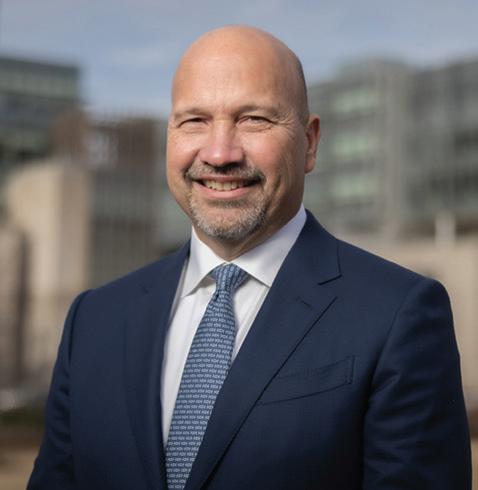
In January, Duke Health said it would partner with UNC Health to build a proposed $2 billion pediatric hospital on an undisclosed site in the Triangle. The state-owned, Chapel Hillbased system announced the freestanding 500-bed children’s hospital in September 2023. Beyond its globally respected medical pedigree, Duke is providing fundraising muscle needed to execute the project, a first of its type in the state.
In March, Duke Health announced a partnership with Novant Health to develop locations across the state to improve health outcomes. No specific projects or financial details were
provided by the state’s second-largest hospital operator (Novant had about $10 billion in annual revenue last year) and third-biggest (Duke had $6.8 billion of revenue in fiscal 2024.)
The organizations said construction of the first sites would begin this summer, with the facilities opening about 18 months later.
Duke Health officials decline to discuss what is sparking the ambitious moves. But consolidation is a major trend in the healthcare industry because of increasing costs of remaining competitive and perceived advantages from economies of scale. Hospital system executives say they need to achieve a significant size to better negotiate contracts with insurance companies and invest in talent, technology and real estate.
Novant Health, which owns hospitals in the Charlotte, Winston-Salem and Wilmington areas, has said it wants to triple its annual revenue to the $30 billion range over the next few years.
That followed a similarly aggressive expansion effort at Atrium Health sparked after the 2016 hiring of CEO Eugene Woods. The Charlotte-based institution now dwarfs its North Carolina peers, with annual revenue topping $32 billion and operations in six states.
Duke Health’s moves follow a restructuring of leadership after the June 2023 retirement of Eugene Washington as the university’s chancellor for health affairs. He had held the post since 2015.

Upon Washington’s departure, Duke Health created two positions. Dr. Craig Albanese became CEO, overseeing the clinical enterprise, and Dr. Mary Klotman was named executive vice president for health affairs. The dean of Duke School of Medicine since 2017, she would “oversee Duke Health’s academic mission,” university President Vincent Price said in a June 2023 release.
Albanese came to Duke in January 2022 from New York-Presbyterian Hospital, where he had been group senior vice president and chief medical officer of the $9.2 billion, 10-hospital academic health system. He is a surgeon who
previously had senior leadership jobs at Stanford University and its healthcare business.
Money won’t be a problem at Duke. The university reported an endowment of $11.9 billion last year and has an alumni roster that includes billionaires such as Apple CEO Tim Cook and Carlyle Group co-founder David Rubenstein.
In December, an anonymous donor gave $50 million to the proton beam therapy center, which is scheduled to open in 2029. It is expected to provide fewer side effects than traditional radiation therapy.
“Hospital affiliations are the new merger,” says Barak Richman, a law professor at George Washington University, referring to the Novant agreement. He is an expert on N.C. healthcare after previously working at Duke. “The idea is you secure patient flows, and you lock up different parts of the market. And, sometimes, that requires less regulatory scrutiny or oversight.”
Duke operates its internationally recognized flagship hospital and a smaller regional one in Durham, plus a third hospital in Raleigh that was acquired in 1998. Since 2011, it has been a partner with Brentwood, Tennessee-based LifePoint Health in the ownership of smaller community hospitals, including nine in North Carolina.
“We recognize the healthcare landscape is changing,” Albanese said about the Iredell County expansion. “While we continue to expand access to care within the communities we serve, it’s also time to do more and deliver care to more people — in more communities.” ■


Keeping growth humming challenges a fourth-generation boss at one of the state’s biggest private enterprises.
By David Mildenberg
Amanda Weisiger Cornelson knows better than anyone that she has big shoes to fill after becoming a fourthgeneration CEO at Charlotte-based Weisiger Group.
Her father, Ed Weisiger Jr., took over as the family businesses’s leader in 1991, when Carolina Tractor and Equipment had annual revenue of $75 million and 175 employees in four offices. The company, which was renamed CTE then Weisiger Group, was founded in 1926.
Thirty-four years later, the business has annual revenue of $1.3 billion, 2,300 employees and 30 branches in five states. “My father has done an astronomical job,” says Cornelson, who became CEO and president in February. “I can’t overstate the high bar he has set.”
Some of that growth reflects the company’s diversification into various businesses. But the main affiliation remains as a dealer for Caterpillar, Hyster-Yale Materials Handling and other equipment manufacturers.
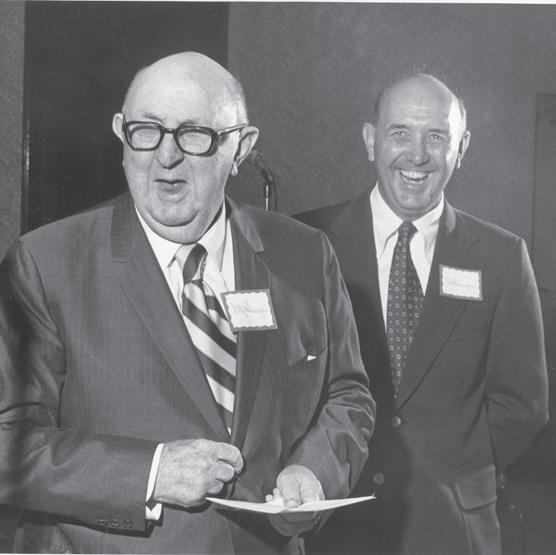
The formal succession process for Cornelson started 2½ years ago when the business promoted Matt Nazarro to the chief operating officer role to help bridge the gap between generations. He had joined the business in 2016 as chief financial officer. Irving, Texasbased Caterpillar is serious about maintaining strong management amid generational change at its franchises.
Cornelson says her path to the CEO job started as a teenager, when she enjoyed hanging around her father and learning about the family business. The company bylaws required that family members work at other companies to “get perspective outside of our bubble,” she says.
So after graduating from Vanderbilt University in 2012, she worked for several e-commerce companies in New York and Nashville, Tennessee, and started her own online retail company that was acquired in 2018.
She then joined Carolina Cat intending to become the leader. “I started earning my stripes, and we were thoughtful as I was having increased responsibilities for [profit and loss],” she says. Working through a variety of departments would help her win “hearts and minds” of colleagues and engage with the community, she adds. “It’s been a special experience in which I’ve done a little bit of everything.”
Those assignments included learning to pull parts to fill customer orders; assist technicians and field service coordinators; run a rental store in south Charlotte; work on the finance team; and most recently, lead the sales organization. Those experiences “make a big impact when problems bubble up,” she says. “Having that foundation gives me a lot of confidence.”
And, she’s learned how to juggle business and family obligations. She and her husband, Shaw, are parents of a 3-year-old son and 1-year-old daughter.
Cornelson’s father remains chair of Weisiger Group’s board. He is also chair of the NC State University board of trustees and co-founder of Charlotte-based Beacon Partners, one of North Carolina’s largest commercial real estate companies. “My dad has been my biggest role model,” she says, including encouraging her to work outside the family business. “I wanted to put in my time

to explore my own interests, and that was great for me. I learned to succeed and fail on my own without the microscope.”
Cornelson’s two sisters, Marshall Weisiger Rodman and Grace Weisiger, share in the company ownership and will rotate as board members.
While
construction equipment may have once ranked as among the most male-dominated businesses, Cornelson notes that women now lead Caterpillar franchises in Alabama, Tennessee, Texas and other regions. “You couldn’t say the same thing 10 years ago,” she says.
The CEO shift occurs with the construction business on a roll in Carolina Cat’s markets, bolstered by population and economic growth and the response to Hurricane Helene. “There is an enormous amount of cleanup needed in western North Carolina. Countless dealers have helped us on [the Helene response],” she says. “It’s been amazing to see how resilient those folks have been because the region has been incredibly devastated.”
Research shows about one in 200 businesses survive into a fourth generation of family ownership, and Cornelson says she’s committed to sustaining the tradition. “We realize how rare that is,” she says. “We will embrace a lot of change in the digital space, and we are very dialed into our service offerings in addition to our `big iron’ business. We’re extremely committed to Cat and Hyster and that won’t change.” ■


Nominees for this year’s Rock & Roll Hall of Fame class are an impressive list. The Black Crowes, Joy Division/ New Order, Mariah Carey and Cyndi Lauper are included among 14 nominees. One band stands out to me: Bad Company made the list for the first time. That’s both awesome, but also incredibly sad to report. The British band formed in 1973, debuted “Feel Like Makin’ Love” in 1975, and was a powerhouse before initially disbanding in 1983. It reunited for tours over the next three decades.
We reached out to North Carolina marketing executive Rick French, chair and CEO of Raleigh-based communications firm French/West/Vaughan, about the nominations. He’s a big Bad Company fan and a Rock Hall board of trustees member. Here’s what he had to say before inductees are announced in late April:



What is your role with the HOF?
I was elected to the board of trustees in 2006 and have spent the past two decades supporting our unique mission to engage, teach and inspire through the power of rock ‘n’ roll.
How do bands get nominated?
A nominating committee comprised of rock ‘n’ roll historians, board members, current living inductees and music-industry executives painstakingly research, debate and ultimately put forward a slate of nominees for consideration by the full voting membership, which is made up of 1,200 artists, historians and music-industry professionals worldwide, the majority of whom are living inductees. So to actually get voted in, the artist really needs the support of a jury of their peers. There is often a misperception that the Rock Hall as an institution or our board puts artists in, or keeps artists out, and nothing could be further from the truth. We work to create a diverse slate and then let the votes fall as they may.
In any given year, five to seven artists are elected, depending on the size of the slate. This year, we have 14 nominees so I expect seven to be elected, but that isn’t assured.
What pushed Bad Company over the top this year?
A board contingent pushed the nominating committee hard for the band’s inclusion on this year’s ballot. And several high-profile inductees threw their considerable weight behind a nomination. I don’t want to name names, but if you follow the connective tissue of Paul Rodgers’ career to other bands or shared labels he was a part of, you might be able to make a pretty educated guess. Note: Rodgers was the vocalist for Bad Company, as well as Free and The Firm.
Why do you think Bad Company deserves a shot?
I’m biased because Bad Company drummer Simon Kirke is a friend. I would have liked for this to be a Free/Bad Company nomination in the same way we nominated Joy Division/New Order and how we inducted The Faces/Small Faces previously.
Plus, Simon allowed me to join some of Broadway’s biggest stars on stage to sing the Free classic, “All Right Now” at Sony Hall in New York City a few years ago, and that song alone should get Free a nomination.
Nonetheless, Paul is one of the greatest rock ‘n’ roll vocalists of all time, and Simon is one of its greatest drummers. Bad Company was a supergroup by anyone’s definition, considering it also included Mott the Hoople guitarist Mick Ralphs and former King Crimson bassist and vocalist Boz Burrell. It delivered one rock anthem after another, from “Feel Like Makin’ Love” to “Bad Company” to “Rock ‘n’ Roll Fantasy.” And if you were in high school in the late ’70s like I was, you couldn’t walk the halls without seeing someone wearing one of those iconic tumbling dice concert T-shirts from the band’s “Straight Shooter” album.
Paul probably didn’t do himself or the band any favors by being so dismissive of the Rock Hall in the past. He has definitely changed his tune, as did Cher last year and Dolly Parton a couple of years ago. It’s hard to push for anyone’s inclusion if it’s a club they say they don’t want to belong to. Are you listening, Oasis? ■
By Natalie Bradin

Everyone loves throwing a fabulous party, though at times it can be tough on the bank account. But a Charlotte couple has found a way to turn their love of event planning and community building into a solid business.
In 2021, Monica and David Hickman cofounded SocialHub, a Charlotte-based event service that provides gatherings for apartment complexes wanting to impress their residents and create a community feeling. By hosting espresso martini bars, crafting sessions and other get-togethers, SocialHub turns a profit while helping the properties retain residents and free their staff for other customer service duties.
SocialHub was born out of the couple’s love of fostering community. They noticed that event planning for multifamily properties usually relies on leasing agents and other staffers, who juggle multiple duties. SocialHub fills the need for community-building events without burdening on-site management.
The Hickmans describe themselves as “two of the most normal people” you’ll ever meet. The couple, who have been married for more than 20 years, met at Montreat College near Asheville, where they were student-athletes. Monica played volleyball and softball, and David was on the baseball team.
After graduating, Monica became an elementary school teacher, while David pursued a degree in theology, then led a couple of nonprofit groups.
“In terms of your average, typical idea of entrepreneurs, we don’t have that background, but we both come from very good, honest, hardworking families,” David says.
While lacking formal business training, their ability to connect with the community and identify areas for improvement have helped them become successful entrepreneurs.
“We’re scrappy, we’re idealistic, but at the same time, we are captured with just a really deep appreciation and love for people,” he says.
During the pandemic, the pair started having conversations with multifamily property management companies, including Charleston, South Carolina-based Greystar, the world’s largest apartment operator. It has multiple properties in the Charlotte and Triangle areas.
With Monica as CEO and David as president, the business raised $125,000 from friends and family. Within 18 months, the business was turning a profit and they have not sought additional outside investment. Revenue reached $1.2 million in SocialHub’s second full year and topped $1.5 million in 2024.
The couple held their first event in Charlotte at a Greystar complex in southwest Charlotte. After receiving positive feedback, they realized the concept would work in other cities with lots of new apartments opening.
Starting in Charlotte, SocialHub has expanded to the Raleigh and Charleston areas, and now works with more than 120 complexes, having added about 30 in the past year. About 25 people work for the business.
“SocialHub is exactly what the multifamily industry has needed,” says Nataile Roman, a portfolio manager with Alpharetta, Georgiabased Pegasus Realty, another large apartment operator.
“Monica and David plan, set up, help host and clean up, allowing the onsite teams to truly connect and be present with their residents,” Roman says. “The residents all love participating in their events, and we have seen an increase in resident turnout and involvement event after event.”
With event services costing from $750 to $1,000, SocialHub has created a consistent revenue stream, opening up opportunities for expansion.
“We have carved pumpkins, made candles, planted herbs for cooking, learned how to arrange flowers, taken a painting class, enjoyed music bingo and picked vegetables from the farmers market,” says Jill Rackley, a Charlotte apartment resident who has participated in SocialHub events.
Apartment vacancy rates have ticked up and record construction in most markets over the past decade. In response, many property managers are offering incentives to fill their units, with some cutting their marketing budgets and others doubling down to retain their lessees. “It’s easy to leave an apartment, but it’s harder to leave a community of friends,” David says.
The Hickmans have a 10-year goal of operating in the largest city in every Southern state and a 25-year goal of having a presence in the largest city in all 50 states.
The company is also considering expanding its offerings, such as assisting apartment managers with broader marketing programs. “We’ve got several different irons in the fire,” David adds. ■







`Chef Curry’ cooks up a plan to revive a storied North Carolina basketball program.

By David Mildenberg
Following recently mediocre results on the court, Davidson College is starting a $10 million-plus fund for its basketball programs..
Initial support for the fund comes from NBA superstar Stephen Curry, his wife Ayesha, and college supporters Don, Matt and Erica Berman. Curry, 37, starred for three years at Davidson, from 2006-09, and has since become an international celebrity because of his unprecedented long-distance scoring for the Golden State Warriors.
Known for generations as an elite, academicoriented school that prepares future lawyers, doctors and preachers, the north Mecklenburg County college became nationally competitive on the court during the 33-year tenure of men’s coach Bob McKillop. His son, Matt, succeeded his father as basketball coach in 2022.
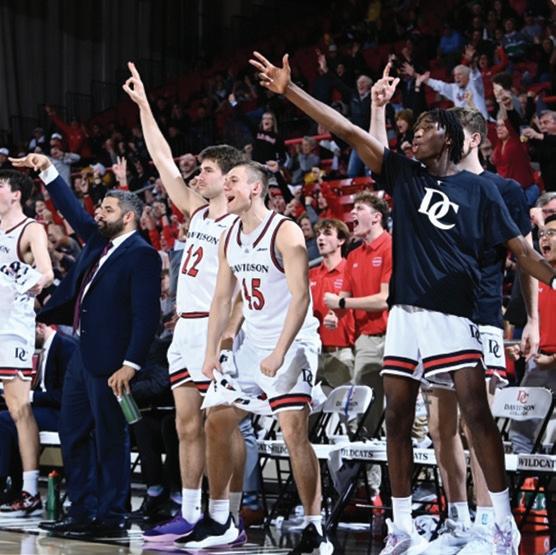

The men’s team has lost about as many games as they’ve won over the past three years, so Davidson is looking for a fresh start. The team ranked 144th nationally at the end of the 2024 regular season, according to basketball analyst Ken Pomeroy.
Meanwhile, the Wildcat women’s team has had five winning seasons since joining the Atlantic 10 Conference in 2014.
Curry and his former Davidson teammate Matt Berman will be assistant general managers, acting as advisers to invest time and experience with both men’s and women’s teams, the college said in mid-March.
Berman’s father, Don, started Cardworks, a consumer finance company based in Woodbury, New York. In January, Cardworks bought a $2.3 billion credit-card portfolio from Charlotte-based Ally Financial. The companies had announced a similar sale in 2020, but the deal was canceled because of the pandemic.
Curry is the first active player in U.S. major professional sports to take an administrative job with an NCAA team. He is earning $55.7 million this year to play for Golden State. He has received $357.8 million from the team in his prior seasons, according to basketball-reference.com.




“I had the opportunity to play basketball at the highest level, got a great education, an amazing network through the Davidson alumni


and continue to wave the Davidson flag,” Curry said via a news release.
“I want very talented, high character studentathletes to have that same experience.”
The new fund could presumably help Davidson become more competitive in offering name, image and likeness contracts to talented basketball players. Details on NIL deals tend to be confidential, but the most elite players are receiving annual compensation of more than $1 million.
“When our basketball programs are successful, they provide much-needed revenue and exposure to support all our athletics programs and raise the overall visibility of the college,” Athletics Director Chris Clunie says.
Davidson President Doug Hicks and Clunie have emphasized that the college is committed to upholding its
commitment to academics and integrity amid major changes in the sports world. They noted that the college’s athletes have traditionally outperformed the overall student body in grade point averages and graduation rates.
Davidson College had an endowment of $1.4 billion as of June 30. The private college has about 2,000 undergraduate students. By comparison, Wake Forest University in WinstonSalem has an endowment of about $2 billion, and enrollment of more than 9,000 students.
To lead the effort, Davidson named Austin Buntz as general manager and assistant athletic director for basketball development. He has helped raise money for athletics at Davidson since 2021. ■




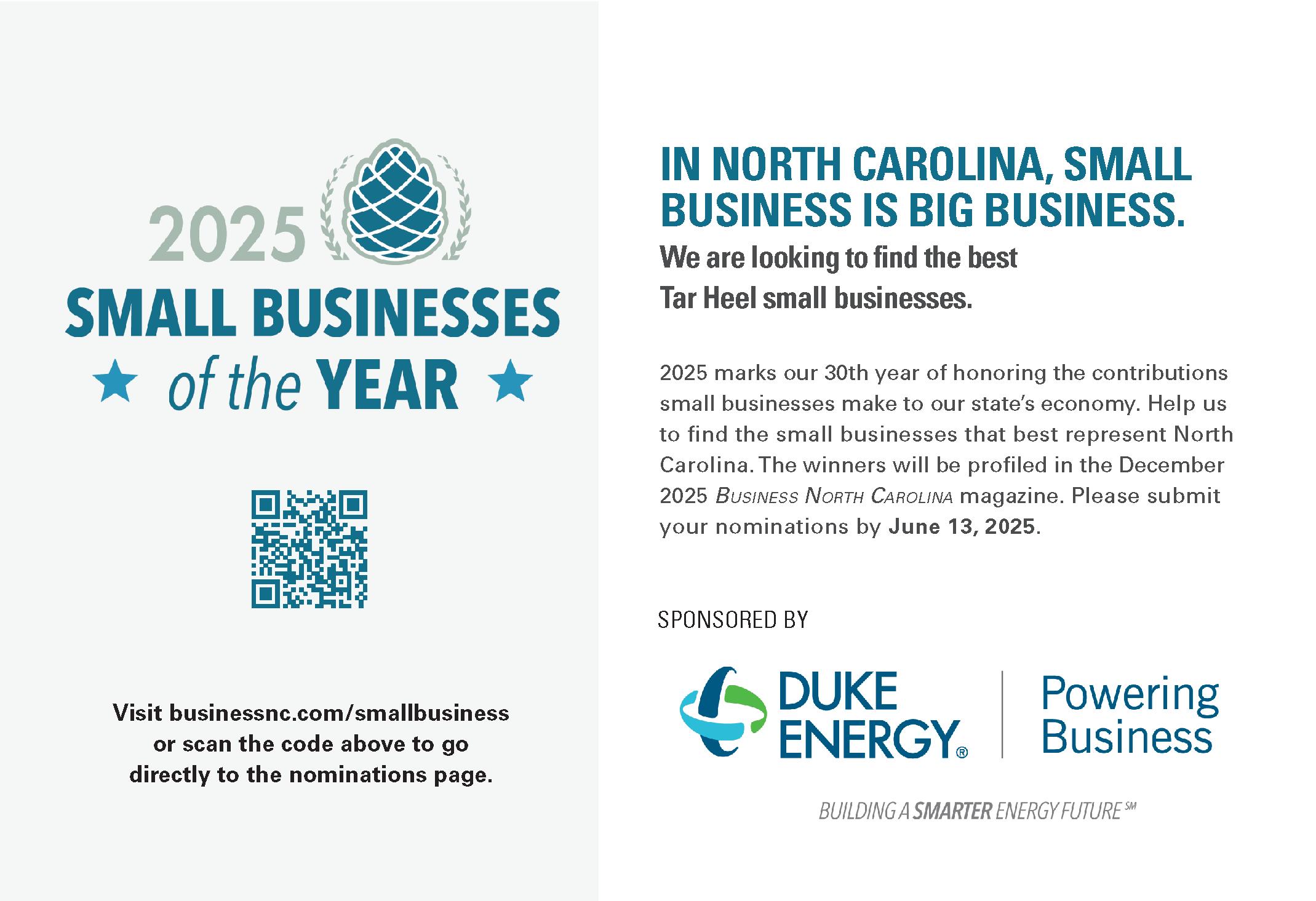






When PNC Bank’s Kyle Huber contemplates the future of North Carolina’s business landscape, he points to robust population growth as one of the state’s most compelling opportunities – and one of its most complex challenges.
There is little question that North Carolina’s growing population, which is estimated to reach 11.7 million by 2030 and 15.4 million by 2060, will fuel continued economic success and innovation. At the same time, sustaining this transformational growth will require significant investment in the state’s infrastructure and public facilities.
Raleigh-based Huber is motivated by the business imperative to build, expand and improve the public institutions that serve the people of North Carolina – from roads and schools to water and wastewater services to nonprofits and higher education institutions. As senior vice president and relationship manager for PNC’s Public Finance group, he helps bring capital projects to life by providing local governments with access to PNC’s resources and capabilities, including traditional bank products through PNC Bank, National Association and capital markets solutions through PNC Capital Markets LLC.
“The strength of our state’s infrastructure is an important factor for economic development initiatives,” says Huber. “Additionally, the local infrastructure contributes to the quality of life that makes North Carolina such an attractive place to live and work. That’s why PNC is committed to helping communities move forward with projects that deliver on this dual objective.”
Never far from Huber’s mind is the responsibility that accompanies the financing of assets and resources that meet the needs of North Carolinians. “As a state resident and taxpayer, I want to see public resources stewarded

responsibly and deployed as strategically as possible,” he says. “As a banker, I help PNC’s Public Finance clients structure deals while navigating shifting markets and external factors of varying levels of complexity, in collaboration with colleagues and local decision makers. One of the most fulfilling aspects of financing a capital project, which can take several years to bring to fruition, is the opportunity to work closely with N.C. government finance officers who put great diligence into managing public interests.”


Among the projects for which Huber and his colleagues are helping lead financing is the expansion of a regional water treatment facility that underpins the surrounding biotechnology industry. For Huber, this project, a joint effort between multiple municipalities, is reflective of the N.C. public sector’s collaboration, master planning, oversight and vision that have catapulted the state to global prominence in multiple industries.
“When you think about some of the municipalities around the Triangle, for example, there are places that have more than doubled their populations over the past 15 years,” says Huber. “Today they are home to campuses of major corporations and thriving communities. This growth has ushered in a new host of demands, so the challenge becomes understanding when and how capital can most efficiently be deployed to meet the goals unique to each community.”



















As Huber explains, financing solutions for these projects are dynamic, often including a mix of bank financing and publicly issued bonds. PNC’s Public Finance group offers both, with PNC Capital Markets LLC serving as one of the most active firms in the state by helping local governments access the capital markets for long-term, fixed-rate taxexempt bonds.





















communities, and my hope is that this deal can serve as a model that could be implemented elsewhere.”
Additionally, Huber is proud of PNC’s work in financing rural capital projects, which often replace community facilities that are in desperate need of repairs or rebuilding. Projects of this nature may include several sources of funding, including bank credit, grants and, potentially, equity.
Meanwhile, in the Outer Banks, Huber is embarking on a water-related project of an entirely different sort: providing a loan to finance the development of housing for ocean rescue staff, including seasonal employees.
“What excites me most about this new workforce housing project is that it will provide a necessary resource for the individuals who make it possible for residents and visitors to safely enjoy the beaches,” says Huber, who in recent years has also helped finance beach nourishment projects to shore up the state’s coastal communities and economies. “Housing supply can be a challenge for many North Carolina
Beyond the deal-making aspects of public finance, Huber believes the continued adoption of treasury management solutions among public sector entities will be critical to their resilience and productivity as organizations protect themselves against cyber threats and streamline processes through automation and digital transformation.
“Each transaction represents a journey for the community,” says Huber. “Each project creates its own set of ripple effects, and I am humbled to play a role in financing infrastructure assets that will support North Carolina’s brilliant future.”



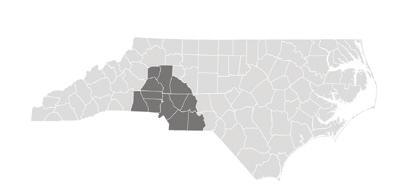
Pamlico Capital closed its sixth fund at $1.75 billion, exceeding its $1.5 billion goal amid strong investor demand. The firm, focused on lower- to middle-market growth equity and buyouts, has raised more than $6.5 billion since 2002, backing companies in tech, healthcare IT and communications.
Charlotte-based Capitala Group, the business investment company led by Joe Alala III, raised more than $1 billion in capital commitments. Since its formation in 1998, Capitala has invested more than $3.2 billion. It focuses on companies with less than $100 million of annual revenue.
Clemson University and Florida State University resolved their legal issues with the Atlantic Coast Conference after a year of lawsuits over how revenue is shared. The two traditional football powers expect to receive more than $60 million annually from the ACC under the new revenue plan.


Coca‑Cola Consolidated’s board approved a 10-for-1 split of the company’s common and Class B shares. Pending shareholder approval, stockholders of record as of May 16 will receive nine additional shares for each share held.
Package-delivery company UPS will lay off 99 mostly part-time workers at a sorting hub on May 2. It laid off 75 workers at the same facility in 2024.
IperionX Limited secured a U.S. Department of Defense contract worth as much as $47.1 million to enhance the U.S. titanium supply chain. The two-year partnership would involve IperionX investing $23.6 million, for a total investment of $70.7 million.
Barings, a global asset manager, agreed to buy Washington, D.C.-based Artemis Real Estate Partners. The real estate investment firm manages more than $11 billion in assets.
Capital One Financial will open its first Charlotte office, leasing a floor at The Line in South End. The bank filed $4 million in renovation permits for the 34,500-squarefoot space. Capital One does not have branches here.

The Consumer Financial Protection Bureau dismissed its lawsuit against Zelle’s operator, Early Warning Services, and its owner banks, including Bank of America, JPMorgan Chase and Wells Fargo. The suit accused the banks of failing to investigate fraud complaints. The case was dropped with prejudice, preventing future refiling.
Odyssey Logistics moved its headquarters here from Danbury, Connecticut. The office includes its executive team and 80 employees.
Bill Thierfelder plans to retire as president of Belmont Abbey College in August, take a year off and then come back to teach at the private Catholic college. The former Olympian high jumper came to Belmont Abbey in 2004 when the school had about 500 students. It now has about 1,600. A relationship with CaroMont Health has led to the opening of a hospital near campus in January and a new nursing program.
Some Lowe’s employees will be getting a bonus of as much as $10,000 after “betterthan-expected” earnings despite “a difficult
home improvement macro environment,” says CEO Marvin Ellison. About $80 million is planned for the bonuses.
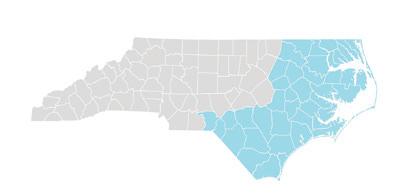
Barrier Fencing Supply, which sells aluminum and vinyl fences nationally, plans to invest $15 million and create 151 jobs by establishing a headquarters and manufacturing center here. The move will relocate manufacturing to the U.S. from Asia, officials said.
Information technology outsourcing firm Provalus plans a $6.48 million investment here that’s expected to create 61 jobs. Based in Brewton, Alabama, Provalus has operations in Whiteville and plans to open a site in North Wilkesboro.
Former Army Master Sgt. Chad McKeown is expanding his Kraken Skulls brand with Kraken Customs, a new car body shop. The shop will specialize in fabrication, performance upgrades, and restorations. McKeown who built a 12-business enterprise, has also pitched a Netflix show on the shop.
A $7.5 million grant from the New Hanover Community Endowment moves the N.C. Aquarium closer to its $56 million expansion, which includes a 350,000-gallon tank, new educational spaces and a 4,000-square-foot rooftop deck. The upgrades aim to enhance marine education, tourism and economic impact in the region.
Chatsworth Products will invest $11 million in an expansion here that’s expected to add about 45 jobs to its 220-member workforce. The Simi Valley, California-based company manufactures infrastructure hardware and equipment for the information and communication technology industries.
Pennsylvania Transformer Technology, also known as PTT, will invest $102.5 million and create 217 jobs in an expansion of its manufacturing facility. The company employs about 77 workers at a factory it has operated here for almost 30 years. PTT makes products for electric utility, municipal power, renewable energy and industrial markets.
First Carolina Bank acquired Pennsylvania-based BM Technologies for $66 million. BMTX and First Carolina forged a five-year partnership in 2023 that brought the fintech almost $450 million in deposits under the bank’s umbrella.








E-commerce giant Amazon said it will create more than 1,000 jobs at a 600,000-square-foot robotics fulfillment center under construction in Wilmington. The project was announced last year, though the number of jobs wasn’t disclosed until a groundbreaking event in March.
Canadian-based manufacturer Advanced Glazings will open a sales office here and plans for a future manufacturing facility. The expansion is expected to create about 50 jobs. The company specializes in glass insulation and light diffusion and is known for its Solera products.
Global aerospace manufacturer Protocase and its subsidiary 45Drives are launching production at a 12,000-square-foot building. Initially projected for 2029, the Canada-based company plans to scale up to full production for both companies within the next year. The facility will produce custom computer parts and is expected to create around 400 jobs.

GE Aerospace is investing nearly $52 million in its Wilmington facility as part of a $1 billion nationwide expansion. The funds will enhance manufacturing capacity, upgrade facilities, and improve efficiency. The site produces components for commercial and military aircraft engines, strengthening North Carolina’s aerospace sector.
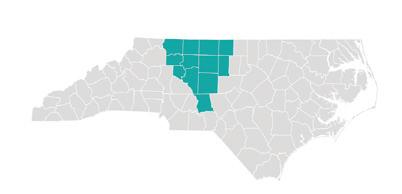
Kontoor Brands, which owns the iconic Wrangler and Lee jeans brands, agreed to buy Norwegian outdoor and workwear brand Helly Hansen in a deal valued at about $900 million. The seller is Canadian Tire, a Toronto-based retail company that has owned the Oslo, Norway-based company since 2018.
UNC Greensboro launched the BRIGHT Institute, which aims to train students for careers in the region’s growing battery sector, bolstered by Toyota’s Liberty plant. Vice Chancellor Sherine Obare says the institute will leverage UNCG’s strengths to position
students for jobs in battery technology and next-generation energy industries.
Seattle-based Amazon.com Services paid $12.07 million for an undeveloped 85.25-acre tract in south Greensboro, near Interstate 85 and South Elm/Eugene streets. The seller is Williams Development Group. Amazon.com had no immediate comment.
Master Plumbers Heating and Cooling, founded in 2000, was bought by Leap Partners of Nashville, Tennessee. Terms were not disclosed. Leap Partners said the purchase is part of an expansion into North Carolina, following the 2023 purchase of Whittier-based Premier Indoor Comfort Systems, which serves western North Carolina.
Syntec Precision Technology, a Chinabased company, will create 34 jobs with
its first North American production and warehouse facility. Syntech produces parts for the hydraulic, life sciences, and transportation industries. The Vance County plant will make parts for medical devices, diagnostic equipment and orthopedic products.
Commercial furniture manufacturer Beaufurn is pledging to create and relocate a combined 57 full-time jobs to an existing plant here with a $929,000 capital investment.
Former HanesBrands executive Jay Turner acquired Excalibur Direct Marketing, which describes itself as the state’s oldest firm of its type. Janie and J.D. Wilson founded the business in 1972. Excalibur has 26 employees with an average tenure of 18
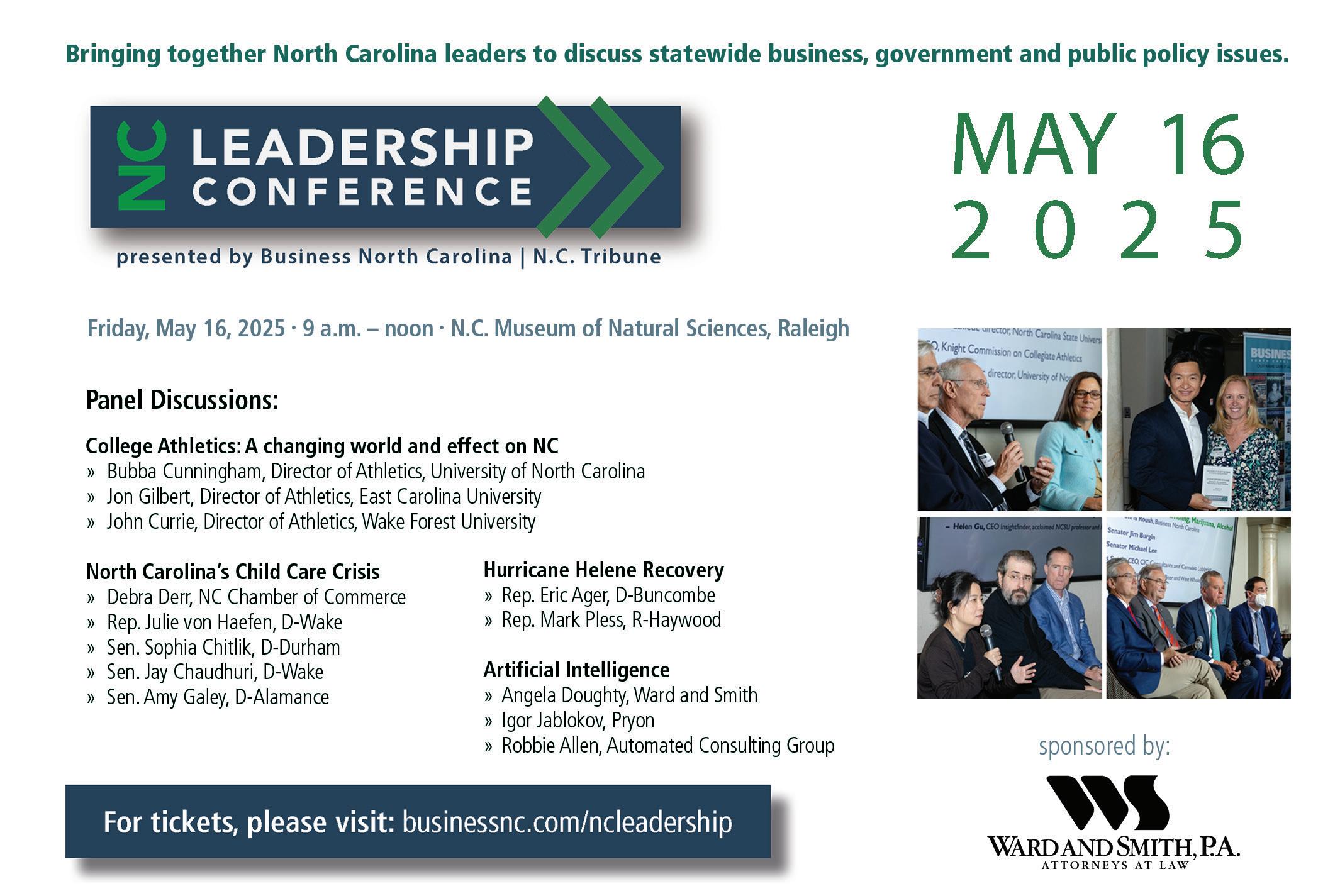

years. President George Newstedt and Vice President of Client Services Ryan Talbert will remain in place.
Quality Oil Company, a familyowned business that employs about 1,500 people at stores and hotels, named Don McIver president and CEO, following the retirement of Graham Bennett. He’s the first person outside of the Bennett family to lead the company, which has 140 convenience stores in four states and about eight hotels. The Glenn and Bennett families have owned the business since 1930.
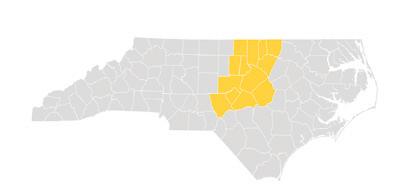
Friendly Barber Shop on East Main Street is closing in April after 64 years. Russ Sturdivant has owned the shop for three decades, after his father, Grady, opened it in 1961. Instead of mirrors and
televisions, the shop’s back wall hosts Tar Heel paraphernalia, newspaper clippings and framed family photos.
Drug developer Chimerix’s history as a promising North Carolina biotech is shifting gears after the company agreed to sell to Dublin-based Jazz Pharmaceuticals for about $935 million. The transaction is expected to close in the second quarter. Chimerix was formed in 2000. Its lead asset is dordaviprone, a small molecule treatment in development for a rare brain tumor that mostly affects children and young adults.
RTI International is cutting 150 jobs, including 80 in North Carolina, following 226 temporary layoffs in February. The nonprofit has relied on funding from the National Institute of Health and U.S. Agency for International Development, which face cutbacks under the Trump administration. It has employed 6,000 people globally and is a leading employer at Research Triangle Park.


Veteran Raleigh lobbyist Kevin Howell was named NC State University chancellor, succeeding Randy Woodson later this spring. It follows a national search after Woodson said he would retire after 15 years, during which he gained national acclaim for boosting the profile of the state’s largest university, with enrollment of 39,000. Howell is a former vice chancellor at NC State who joined UNC Health in 2024 as chief external affairs officer.
Duke University’s 6,500 undergraduate students learned that the total cost of attending for the 2025-26 academic year would top $92,000, versus about $41,000 in 2005. In February, Duke’s board approved a 5.9% increase. Many students pay less than the full cost because of scholarships and grants. Duke’s admission rate has been less than 10% of applicants in recent years.
Digital health firm Lumata Health raised $23 million to double its workforce to 400 employees. The company partners with ophthalmology practices to help patients adhere to treatment plans. Investors included LRVHealth, McKesson Ventures, and Cencora Ventures, with money to be used for care coaching, data, and technology teams. Lumata serves about 3,000 to 4,000 new patients monthly.
Access Newswire, which was called Issuer Direct until January, agreed to sell its compliance business to New York Citybased Equiniti Trust for $12.5 million. Access says it will use $12 million to pay down debt. The sale includes the transfer of the 11-employee compliance team, client contracts, intellectual property and other related assets. Access is focusing on its communications subscription business.
Ralliant Corp., spun off from Everett, Washington-based Fortive in February, will invest $2.1 million and create 180 jobs that pay more than $189,400 on average, more than twice the current average wage ($76,643) in Wake County. Ralliant was formed from Fortive’s Precision Technologies segment and is built on industry-leading brands with approximately $2 billion in revenue.
A settlement between the State Insurance Department and the insurance industry will result in an average increase of about 15% in home insurance premium base rates by mid-2026. The industry’s N.C. Rate Bureau had sought a 42% average increase. The rate hikes will be implemented in two stages.
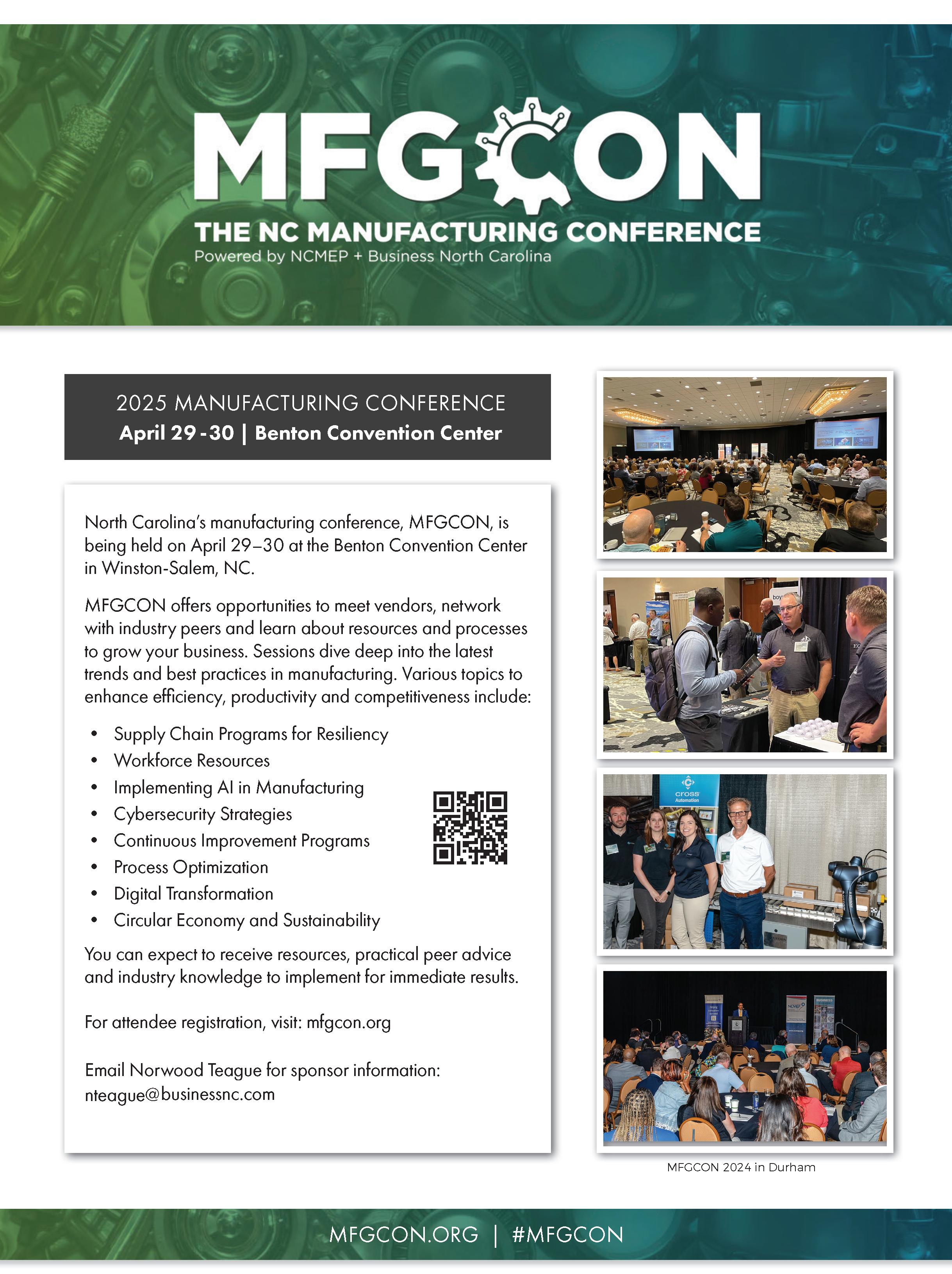
North Carolinians wagered more than $6.1 billion in real money bets in the first year of legal sports betting, with operators earning $713 million in gross revenue. The state collected $128 million in taxes, which mainly funds UNC System athletics and gambling addiction programs.
Captrust Financial Advisors acquired Charlotte’s Carolinas Investment Consulting, which oversees about $1.4 billion in assets. The 20-member firm will be Captrust’s second location in Charlotte. It also has offices in Greensboro, Raleigh, Sanford and Wilmington as part of a national network of more than 80 locations.
Raleigh Golf Association, the city’s oldest public course, is set for a $3.5 million renovation by McConnell Golf, including a new 60-bay, lit driving range. Course architect Kris Spence of Greensboro will lead upgrades, while rezoning plans could turn the north side into residential development, preserving affordable public golf on the city’s south side.
North Carolina state employees and retirees may see their health insurance premiums increase. The state insurance plan is projected to have a $500 miillion shortfall in 2016 and $800 million in 2027, State Treasurer Brad Briner told state leaders.. The plans have about 750,000 enrolled.
42nd Street Oyster Bar, a staple with state government officials and lobbyists since 1931, was expected to close March 30. Originally a fish market offering oysters and craft beer, it became a bar in 1987 and was a favored seafood spot.
After two decades of development, a new lightweight metallic material created by NC State University engineering professor Afsaneh Rabiei and her Raleighbased company, Advanced Materials Manufacturing, launched a commercial product. The company claims the material is “as strong as steel yet as lightweight as aluminum,” likening it to a metal bubble wrap.

Raleigh-based Golden Corral’s spinoff chain Homeward Kitchen will be replaced by the rebranded Golden Corral Favorites. The venture aims to serve the brand’s signature comfort foods in a smaller format. Homeward Kitchen launched here in late 2023.
FirstCarolinaCare will no longer offer insurance plans past 2025, with the exception of Medicare Advantage. The organization cited medical inflation, rising prescription drug costs, higher volumes of chronic conditions and rising technology costs as factors. FirstHealth of the Carolinas started the insurer, which has been majorityowned by Urbana, Illinois-based Carle Health since 2020.

Asheville-based Aeroflow Health recently hit its 1,000th employee milestone and moved into a new 51,000-squarefoot fulfillment center that is expected
Time included The Radical boutique hotel in its annual World’s Greatest Places List. It’s the only Tar Heel site on the list, which includes places to stay or visit. In November, Business North Carolina selected The Radical as its “hospitality category winner” in our 11th annual feature on the most important new buildings that opened across the state in the past year.
to process 17,000 orders per day for customers nationally. It will start with 65 employees. The company had 1.4 million customers in 2024 and distributes breast pumps, glucose monitors, diapers, CPAP machines and other products. It expects to fulfill 3 million orders in 2025.
The UNC System didn’t travel far in its search for a new chancellor at Appalachian State University. Heather Hulburt Norris had been the interim chancellor since April 2024 after succeeding Sheri Everts, who stepped down after 10 years due to “significant health challenges.” Norris has been at the university for more than 20 years.
North Canton, Ohio-based Timken is closing the Alexander County manufacturing facility it acquired two years ago, resulting in the loss of 58 jobs. The manufacturer of bearings and power transmission products says the first layoff s will occur July 31 and continue through the end of the year. Timken bought the assets of American Roller Bearing in February 2023. ■


Education programs demonstrate careers in rural areas can provide bright futures.
NC State’s Rural Works! program places engineering students in summer internships with manufacturers in rural counties. The basic gist is that employers gain talented summer help, while students receive practical experience.
The bigger idea is to help rural counties struggling with population losses show these students engineering opportunities. They might come back after graduation.
North Carolina is a mostly rural state with its prosperous urban areas of Charlotte and Raleigh showing a lot of population growth. Outside of the metros, it is a different story. In this decade, 20 of the state’s 100 counties will lose population, according to projections. Another 10 will grow 1% or less.
There are a bunch of historic reasons. Many small manufacturing plants that used to make textiles, apparel and wood furniture have closed. Foreign competition and automation took a lot of these jobs away.
A lot of kids from rural areas go off to college and don’t come back because of opportunities in the cities. Some research shows that only around a quarter of college students from rural areas returned to their home county after graduation.
Rural Works! splits the cost of the internship. Employers pay $15 an hour and NC State’s College of Engineering pays $10. So the student gets $25 an hour. It is run by NC State’s Industry Expansion Solutions, the manufacturing extension arm of the university, in coordination with the Career Development Center and the engineering college. Anna Mangum, an IES regional manager, recruits and works with manufacturers, Career Development and the college to promote the program among students.
Since starting with four students in 2019, the program has placed 600 engineering students in internships. Last summer, 147 students worked at 83 companies, spread across 39 counties.
The program’s budget caps out at 150 students. In midJanuary, 103 positions had been posted. “There are 1,852 applicants from our students against those 103 jobs,” says Mangum. She had a client who was slightly overwhelmed because he had 100 applicants of students wanting to gain experience in his machine shop.
Nathan Kiger of Nash County had an internship last summer and is returning this to the same employer, Evans Machinery of Wilson.


Kiger, who grew up on a sweetpotato farm, is a junior majoring in biological and agricultural engineering. He was steering tractors in the field when he was 4, sitting in granddad’s lap. By 13, he was driving the tractor by himself.
He grew up fascinated by agriculture and by all the mechanical stuff on the farm. That was the story of agriculture in the second half of the 20th century, the spread of tractors and other equipment.
Evans is a nearly 50-year-old family business that manufactures and repairs complex tobacco processing and other agricultural equipment commonly found on eastern North Carolina farms. This was a good place for Kiger to intern.

“I used a lot of my classes very quickly,” he says. Evans put him to work on real projects. We discussed tender trailers, the kind of thing used to haul fertilizer from a distributor to the farm, where the stuff would be dumped into a spreader. There are a lot of hydraulics needed to push out the fertilizer. Kiger had to size the hydraulic lines.
“In fluid mechanics, you don’t exactly learn how to size a hydraulic line,” he says. But he had experienced folks around him at Evans who helped him.
He worked on the redesign of a fertilizer bucket elevator, which is used to move the fertilizer to another stage in processing. He went out to help with installations, and saw the difference between designs on a computer and what equipment looks liked in a customer’s building. Subtle things that he would use to tweak his designs.
Next summer, he will be on the road as the engineering guy on sales calls and going out on more installations. It will be more of a customer-facing role, and he’s looking forward to another summer with Evans.
And Evans is looking forward to another summer, and, they hope, longer with Kiger. “He’s a smart guy,” says Amanda Barnes, president of the company. She’s the daughter of Donald Evans, one of three brothers who founded the business. (Bobby and Tony were the others.) “He’s friendly. He’s knowledgeable, well-mannered, so we really want to try to hang on to him.”
Evans has an innovative culture. Kiger was encouraged to try new designs, new features, not just follow what had been done before. He fits the culture.
“He was willing to get in there,” says Barnes, “and say, ‘Yeah, we got it this way, but, hey, let’s see what it’ll look like if we tried it this way. Move this on this drawing and change it up a little bit.’ Lots of time, that’s what we all need, which is fresh eyes to look at something.”












At the same time the Evans brothers were launching their company in 1979, my wife and I got married in southwest Virginia, where we had both started working after college.
My wife grew up on a Sampson County tobacco farm in eastern North Carolina, and I can remember 40 years ago meeting people on our visits to see her family in Clinton who would tell me their kid had gone off to college and was now living in Cary.
Cary, just west of Raleigh, had grown from 7,700 residents in 1970 to nearly 22,000 in 1980, the result of RTP’s growth and the arrival of the up-and-coming software company SAS, which spun out of NC State. Today, Cary has a population of more than 180,000. Many residents are from other states and countries, but more than a quarter are from North Carolina. Some are Cary natives, but not all.
In the old days, most of the kids from rural counties would come back from college to learn how to run a factory, work in the bank, or, like my father-in-law, to run the family farm. Then Raleigh, Charlotte, Durham and Cary and other cities became powerful draws, pulling a lot of talent out of the rural areas.
There are good ideas to build up the rural talent pool, such as Rural Works! NCEast Alliance has a program to show students career possibilities around them in 29 eastern counties. Also promising are the community college training programs for the expanding biomanufacturing sector in the region. I have written about the expanding aviation and aeronautics sector that has found a hub at the NC Global TransPark in Kinston.

This is a slog, economic development in rural counties. To a large extent, it is a talent recruitment/retention project. Wins are hard-earned, and we need to celebrate them one engineering student at a time. ■

Veteran journalist Dan Barkin writes the NC Military Report newsletter for Business NC. Originally from Newton, Massachusetts, Dan moved to the South for college before settling in North Carolina in 1996. He can be reached at dbarkin53@gmail.com.

































by Allen N. Trask III and Amy H. Wooten
We are attorneys and don't sell or broker insurance. Yet, we're writing to alert business owners of a direct threat posed by a "set it and forget it" approach to insurance coverage. Why? Because we see firsthand the damage this approach can cause as we litigate claims that business owners bring and defend against their insurers.
During the last five years, government shutdowns, supply chain disruptions, material price increases, and substantial and costly property losses resulting from natural disasters like Hurricanes Florence, Dorian, Isaias, and, most recently, Helene have highlighted for business owners the importance of making it a routine business practice to take stock of the types and extent of insurance coverages their businesses have in place.
The hot topic during the height of COVID-19, and for quite some time thereafter, was how businesses could recoup their losses when mandatory government shutdowns required them to shutter their doors for a period of time.
Business owners also sought possible relief through insurance as business income/interruption loss claims. A valuable lesson coming out of COVID for any business that owns property is the importance of how market and supply chain disruptions impact pricing relevant to


commercial property insurance policies, particularly those with replacement cost coverages and those with co-insurance penalties.
Increased market costs for labor and material translate to increased repair and rebuild costs, which may mean your once appropriately insured-to-value commercial property is now underinsured.
This isn't just an important consideration for your business, though; it should also factor into your thought process when considering businesses you are contracting with and how, through contract terms, you can further protect and mitigate risks for your company.
Turning back to the search for a way to recoup the losses that many businesses sustained during the suspension of operations due to government orders during COVID, there was a wave of claims and litigation across the country sorting through whether such orders and their resulting impact were covered losses.
These issues were still on our courts' dockets even late last year. The North Carolina Supreme Court took up and issued opinions in two cases last December.
In one case, the Court determined that the language of the policy at issue was not clear in defining "direct physical loss"
to exclude circumstances in which the insureds could not use their insured property due to government orders or threatened viral contamination.
In a companion case, the Court determined that there was no coverage where the policy at issue expressly excluded viral contamination as a covered cause of loss.
Both of these cases illustrate the importance ascribed by North Carolina's courts to the language in insurance contracts and, for business owners, the value that can come from having a basic understanding of how the courts read and apply those contracts to reach an answer.
We read insurance contracts not to sell them but to help business owners fully understand both the risks mitigated by and left unattended to in their current coverage portfolios. In the event of a significant loss, that type of counsel can be tremendously helpful and can be the difference between receiving the claimed benefit or being left holding the bill.
Insurance is not a risk management tool that North Carolina business owners can afford to relegate to the bottom shelf...

Another lesson, and for a significant portion of the State, a heartbreaking one, came last September when Hurricane Helene exposed a significant gap in insurance, impacting many businesses. These businesses either did not have any flood insurance, perhaps because they were not in an area mapped as a flood zone, or the coverage they carried through the National Flood Insurance Program (NFIP) was insufficient to cover the extent of their losses. Currently, NFIP commercial policy limits are capped at $500,000 for buildings and $500,000 for contents.
Hurricane Helene proved to be a stark reminder that even areas in the State thought to be unlikely to or not prone to flooding are not immune from the dangers and damage of flood waters. It confirmed for all businesses having commercial properties the importance of giving due
consideration to whether they need flood insurance and, if so, whether the NFIP's offerings are likely to prove sufficient in the event a flood loss occurs.
Suffice it to say, insurance is not a risk management tool that North Carolina business owners can afford to relegate to the bottom shelf only to be pulled out when the need to use it arises. Thankfully, failing to take a policy and terms inventory on a routine basis is a mistake that all businesses can easily avoid.
Keep in mind, though, that regularly assessing your business's insurance portfolio is the bare minimum a company should undertake in this area of its risk management efforts. Further assessments are warranted when changes occur to or within the business or when new risks in the market and industry are reasonably expected to impact the business.
For additional information on mitigating insurance business risks or litigating on behalf of commercial policyholders, please get in touch with us.


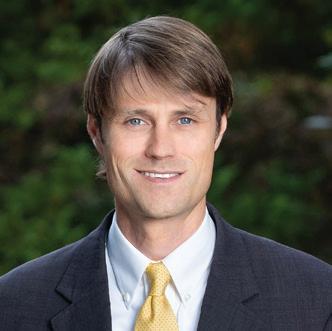

Allen
N. Trask III Litigation Attorney ant@wardandsmith.com
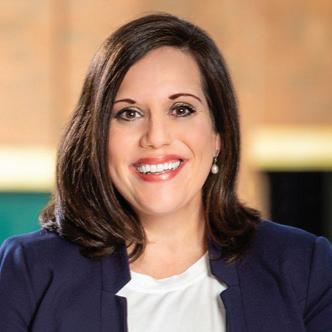
Amy H. Wooten
Litigation Attorney
ahwooten@wardandsmith.com
wardandsmith.com

This article is not intended to give, and should not be relied upon for, legal advice in any particular circumstance or fact situation. No action should be taken in reliance upon the information contained in this article without obtaining the advice of an attorney.






People and businesses are flocking to southeastern North Carolina. Brunswick, New Hanover and Pender counties are working to ensure they have what they need to live and work.

Southeastern North Carolina is home to the state’s fifth- and sixthlargest counties by area — Pender and Brunswick — and its second-smallest, New Hanover. Its 328 square miles is about the size of Charlotte, the state’s most-populous city. Together they form the Wilmington Metropolitan Statistical Area. With a population nearing 500,000, it’s one of the nation’s fastestgrowing regions.

Wilmington topped United Van Lines’ 2024 National Movers Study, which found 83% of household moves there were inbound. The New Hanover County seat’s population was nearly124,000 in 2023, according to N.C. Office of State Budget and Management estimates, nearly 10,000 more than in 2020. That growth has been spurred by a blossoming job market, attractive beachfront communities and relatively

low cost of living. Some people are here for an education. “We talk a lot about the film industry, our port, our restaurant scene and so many other key economic drivers,” says New Hanover County Manager Chris Coudriet. “But we are also a very big college town. Combined, [UNC Wilmington] and Cape Fear Community College have nearly 50,000 students taking part in classes. That’s a tremendous amount of people in various stages of their educational journeys in our community.”
Coudriet says the county has a broad makeup. “A lot of people are here for a lot of different reasons, and that’s something we really embrace,” he says. “Obviously, we have a thriving tourism industry driven by our proximity to water. We also have become a destination for folks later in their lives or careers who are looking to settle down.”

The region attracts commerce, too. “Our location between both the Wilmington and Myrtle Beach MSAs makes it a competitive and viable area for business and industry development opportunities, as well as its vibrant beach towns and growing municipalities,” says Brunswick County Manager Steve Stone. “Brunswick has a long and fascinating history dating back to before the American Revolution, and its proximity to Wilmington and the Atlantic Ocean, along with its low tax rate, has made it one of the most desirable places to live, visit or start a business.”
A growing population and economy are good problems to have. But they still create challenges. Each of the three counties are meeting them by developing and enacting proactive strategies.



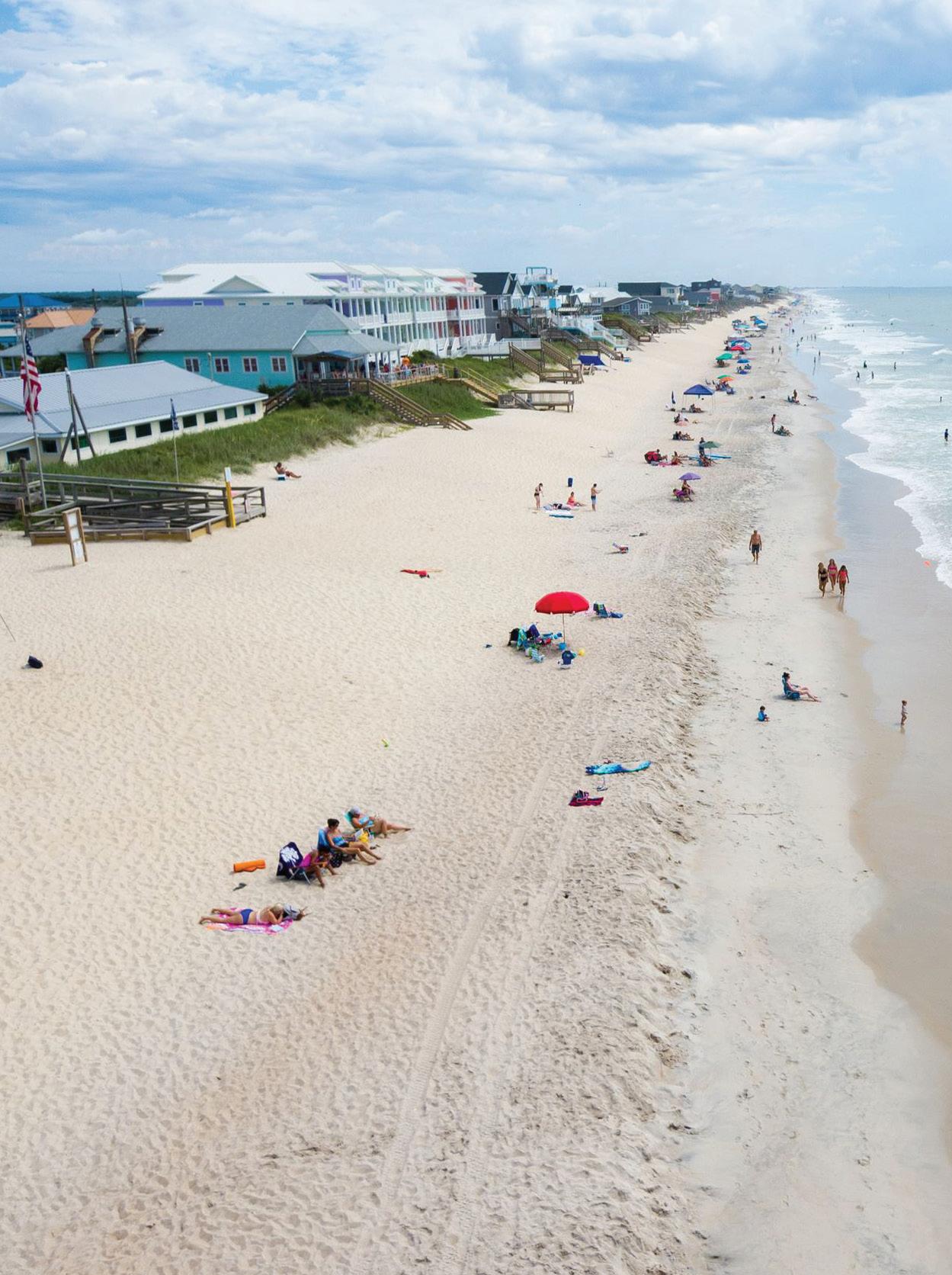

Wilmington Business Development, an economic development agency that partners with government and community leaders in New Hanover and Pender counties, lists 26 industrial, commercial and logistics properties. They include Pender Commerce Park, which has more than 1 million square feet of industrial space, $500 million in private capital investment and more than 1,000 jobs.
Pender Commerce Park investors include Maersk, The Home Depot and Amazon, which is building a 3.2 million square foot fulfillment center, where 1,000 people are expected to work, at the 330-acre park. Other park tenants are Acme Smoked Fish, Empire Distributors, FedEx Freight, Coastal Beverages and Polyhose, which will double the size of its 52,500-square-foot factory later this year. “[The park] has been a tremendous asset to our county thriving thanks to the strong partnership with Wilmington Business Development and the industries that have established themselves there,” Pender County Manager Michael Silverman says. “This success has generated significant revenue for the county, created jobs for our residents and spurred further growth and development throughout the area.”



Sandbar Oyster Co., which recently leased a building in Leland, has put its Oyster Catcher Substrate to work on Sugarloaf Island. It’s retaining sand, catching shells and supporting marsh grass growth.

New Hanover is developing Blue Clay Business Park. “We received $15 million in state funding for … infrastructure off Blue Clay Road in the northeast portion of the county, which will help bring infrastructure to this 120-acre site, allowing businesses to take root in our community with the space they need,” Coudriet says. “We already have multiple agreements in place for several businesses who are either looking to build or expand current operations at the Blue Clay Business Park.”
New Hanover also is home to the 284-acre Port of Wilmington on the Cape Fear River, 26 miles upstream from the Atlantic Ocean and part of Foreign Trade Zone 214. Its 2024 general cargo volume was up 11% from the year prior, according to a January news release. “[The port’s volumes were] primarily driven by commodities supporting U.S. infrastructure, construction and the automotive industry such as lumber, cement and steel. Volume forecasts show this trend continuing … into early 2025,” the news release said.
Military Ocean Terminal Sunny Point, one of the world’s largest transfer points between trains, trucks and ships, imports and exports weapons and equipment for the U.S. Army in Brunswick County.
Barnes Sutton, Leland’s economic and community development director, says nearby Leland Innovation Park is “poised for significant growth,” with plans for new industrial, commercial and office facilities.
Leland’s target industries are life sciences, information technology, medical technology, aerospace, marine biology and wind energy.
“Our recruitment strategy begins with supporting existing businesses in these sectors, as most job creation comes from companies already operating here,” Sutton says.
Sandbar Oyster Co., for example, leased a 2,000-square-foot building in Leland last year to manufacture and distribute its Oyster Catcher Substrate, a cloth-and-cement device that its namesake shellfish settle on and grow.
“Their decision was influenced by the region’s skilled workforce, bolstered by programs at UNC Wilmington, Brunswick Community College and Cape Fear Community College,” Sutton says.
“These institutions produce graduates with expertise tailored to industries like marine biology, which aligns perfectly with Sandbar’s growth trajectory.”



Brunswick County’s population is the state’s fastest growing. It increased 17% between 2020 and 2023. Leland, the county seat, had a population of 30,264 in 2023, according to the N.C. Office of State Budget and Management, more than double the 2010 count. “Situated between the city of Wilmington and the serene Brunswick County beaches, Leland provides the best of both worlds – proximity to city amenities paired with a relaxed, small-town lifestyle,” Sutton says. “Our growth has been fueled primarily by thoughtfully designed planned unit developments, featuring single-family homes, multifamily residences, and a mix of commercial and industrial spaces. These developments are carefully integrated with Leland’s natural environment, preserving forests, wetlands and waterways to create communities that honor the area’s ecological heritage.”
Several plans are in use to address Brunswick’s population growth. The Board of Commissioners has identified six focuses within its strategic plan: economic development, education, excellent government, growth and sustainability, healthy and safe community, and engagement and connection.



The Gullah-Geechee Tourism Alliance bring together businesses, tourism bureaus, cultural institutions and residents for discussions and planning around the topic of boosting tourism.

Blueprint Brunswick 2040 Plan was adopted in February 2023. “It was a joint effort between our planning and parks and recreation departments to create a new comprehensive land use plan and a parks and recreation master plan,” Stone says. “These plans will guide future growth, decisions, investments in infrastructure and services within unincorporated Brunswick County and six participating towns – Bald Head Island, Belville, Bolivia, Navassa, Northwest and Sandy Creek. The Blueprint Brunswick Plan is not a legal document, but it is a guide that staff regularly consults and reviews to help make recommendations to developers and ultimately the Planning Board when projects are brought for consideration.”
The county is working with consultants on proposed updates to modernize its Unified Development Ordinance. Three community meetings were held in January to help guide growth and development in unincorporated portions of the county. The ordinance lists 14 purposes, including preserving overall quality of life, protecting the character of established residential neighborhoods, encouraging environmentally responsible development and maintaining a range of housing choices and options.
Leland recently completed a residentdriven Economic Development Strategic Plan. Long-range planning for growth was prioritized by 37% of the responses. It was followed by transportation infrastructure, which was prioritized by 17.4% of the responses. “We’ve taken that input and have recently added additional resident feedback for the town’s 2030 strategic plan,” Sutton says. Priorities include implementing a business retention and expansion program, entrepreneurial support, an economic development fund, updating the tourism plan, and beatification and public art.
Sutton says there needs to be balance between past and present. “Our area is rich in managed and natural spaces, home to diverse wildlife habitats and unique ecosystems,” he says. “Many of our developing parks offer direct access to these ecological treasures, which feature rare species, important animal populations and other significant natural features. Leland is also part of the Gullah-Geechee Heritage Corridor, a deeply rooted cultural area that celebrates its history, music, food and dance. This heritage is honored annually right in the center of the downtown Gateway District, fostering a vibrant sense of community.”




Destination NHC 2050 prepares New Hanover County to meet needs such as adding affordable housing, preserving greenspace and creating high-wage job opportunities. “It’s a sturdy framework but not rigid and will be able to move with our community forward with the best strategies for land use,” Coudriet says. “We really want the community to be involved in building that plan, so we can understand how our residents envision the future of New Hanover County, and our planning and land use team has been working very hard to gather that information and make sure it’s reflected in the plan that’s being developed.”
The county’s Workforce Housing Services program began in 2022. It started with $15 million to be distributed over five years, and it has proved $9 million to date for 664 units. In October, commissioners approved its third installment of $3 million, divided among three organizations to create 238 units. “It’s not enough just to have good paying jobs, which [county commissioners] have fostered with economic incentives as well,” Coudriet says. “Our commissioners also want to make sure those people can



New Hanover County is home to unique natural resources, including beaches and waterways. The local cultural scene is vibrant, showcasing food and the arts. It, along with expanding employment opportunities, attracts new residents.

afford to live in the community where they work, which is why this program is so important.”
Last Frontier Project continues preparations for residential and commercial development. “Outside of these city limits there are a lot of areas in the county that are unincorporated and are not connected to municipal services like water and sewer,” Coudriet says. “The Last Frontier Project is one of the biggest undertakings to address that, ensuring our residents have access to safe, clean drinking water and strategic development can take place with reliable infrastructure. In partnership with the Cape Fear Public Utility Authority, we’ve been working to fill that infrastructure gap to these underserved areas. The Last Frontier is going to be a $39.6 million project, $30 million of which will come from state-issued funding.”
Coudriet says the county is focused on spending tax dollars in ways that benefit all residents best. “Whether that’s access to greenspaces, like our parks and gardens, or connecting them to libraries in their own neighborhoods, we really want people to find the things that they enjoy and enhance their quality of life,” he says.


Pender County’s population grew 12% between 2020 and 2023 to 67,464, according to N.C. Office of State Budget and Management. That was the second-largest percentage gain in the state. Its 934 square miles encompass rural neighborhoods, protected game lands, and oceanfront communities Surf City and Topsail Beach. The Moores Creek National Battlefield, which commemorates a 1776 defeat of British troops during the American Revolution, welcomed 53,700 visitors in 2023. There’s plenty of farmland, too.
Pender had 354 farms covering 44,472 acres in 2022, according to the latest U.S. Department of Agriculture statistics. Its primary crop is blueberries. The annual NC Blueberry Festival in Burgaw celebrates the berries’ historical, economic and cultural significance with a 5K run and walk, antique show, car show, craft and food vendors, children’s activities and live music.
Imagine Pender 2050 was launched a year ago. It’s in the fourth of five stages and is expected to be adopted this summer. “[It] will guide change in our community over the next 25 years, including identifying areas for new development,” according to the county website.
Residents’ initial feedback for the plan emphasized overcrowded schools, draining and flooding issues, regulating development in order to protect nearby property values and minimizing development of new housing while requiring new homes to be placed on lots of a half-acre or larger if possible. They also mentioned the county’s need to support and fund programs to help farmers. ■
Throughout the year, Burgaw has several blueberry-themed events such as the NC Blueberry Scholarship Pageant and a pancake breakfast, which is held each February to raise funds for the NC Blueberry Festival.
offer plenty to see. There are lighthouses, historical sites and barrier island communities to explore. A lively downtown and Battleship North Carolina await in Wilmington. That’s where you’ll find Airlie Gardens, which travel website Orbitz named the state’s best place to get married. “Yes, we are small in terms of land mass, but there is no shortage of things to do and engage with throughout our community,” says New Hanover County Manager Chris Coudriet. Plenty of people are doing just that.
New Hanover recorded more than $1.1 billion in visitor spending in 2023, a 5.9% increase from the year prior, according to a study commissioned by Visit North Carolina, the state’s tourism booster. The industry employed 6,790 county residents and paid a total payroll of $2.8 million that year. “During calendar year 2023, countywide room occupancy tax collections totaled more than $24.9 million, an increase of 4.94% over the previous [Return on Travel) benchmark set in 2022,” Kim Hufham, president and CEO of Wilmington and Beaches Convention and Visitors Bureau, said in a news release. “This continued growth can be attributed to our visitor-friendly destination that embodies the best of the Carolina coast.”
Brunswick visitors spent almost $1.2 billion in 2023, the sixth most in the state and 7.5% more than the year prior, the study found. “Brunswick County also has a rich agricultural tradition and seafood industry history,” says Brunswick County Manager Steve Stone. “Our six vibrant beach towns, including two of the seven North Carolina lighthouses, and our vast coastlines have made Brunswick County a popular tourism destination.”


Pender County study found domestic and international visitors spent $199.1 million in 2023, up 5% from the year prior. About 1,000 county residents worked in the industry that year, when its payroll was $40.4 million.
— Kathy Blake is a writer from eastern North Carolina.

North Carolina’s economy doesn’t stand still, thanks in large part to its transportation industry. It keeps commerce moving along 3,100 miles of freight railroads, through two ports, at four international airports and down the road to more than 150 million customers, all of which are within a day’s drive. Business North Carolina magazine recently gathered some of the industry’s biggest movers to discuss its status, where it’s headed and the challenges it faces, from rebuilding after Hurricane Helene to navigating tariffs. The conversation was moderated by Managing Editor Kevin Ellis. The transcript was edited for brevity and clarity.
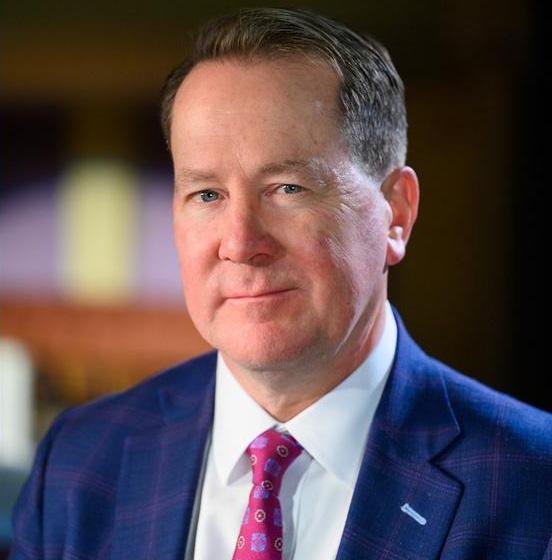
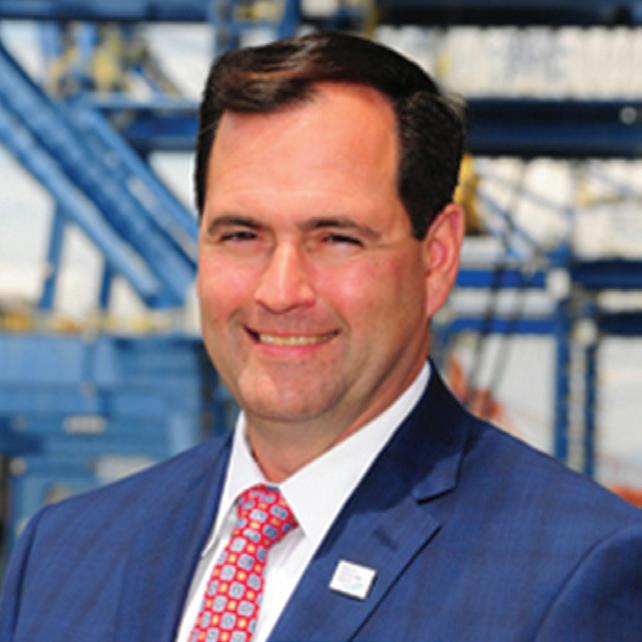
The discussion was sponsored by:
•Guilford Technical Community College, Greensboro
•I-77 Mobilty Partners
•N.C. Railroads
•Piedmont Triad International Airport Authority
•N.C. Ports Authority

GREENBERG: Trucking has been in a freight recession for several years. We’re seeing some green shoots, but we don’t have a pasture full of produce yet. The uncertainty surrounding the Trump administration’s tariffs is concerning, particularly their effect on trucking and the supply chain. That’s keeping my members up at night.
WARREN: The new administration has different priorities. We need to understand which ones will move forward. I think about it in the context of railroad infrastructure investments, whether that’s private companies, government funding or a combination of those. Not knowing is challenging for Class 1 railroads, including CSX Transportation and Norfolk Southern. We live in a world where no matter the economy’s condition or the prospects, partnership is key to moving forward.
CLARK: The container industry is changing significantly in real time. As I look at our future, where will North Carolina’s ports be included in vessel rotations, and how does that influence the volumes handled and the investments needed to continue growing?
FOX: N.C. Department of Transportation has two challenges: rebuilding western North Carolina after Hurricane Helene and

Garcia CEO, I-77 Mobility Partners
supporting projects across the rest of the state. Infrastructure in the mountains was hit hard, about $5 billion worth of damage. The federal government will reimburse most of that, but we must repair it so folks can use it. One lane in each direction of Interstate 40 through Pigeon River Gorge reopened March 1. People, goods and services must move to every part of the state, so we continue projects statewide.
BAKER: The COVID pandemic was like throwing a bowling ball into a still pond. It made an immediate splash, but its ripples continue. Those include a pilot shortage; many took early furloughs, then airlines couldn’t get them back fast enough to fly. Demand spiked, but there weren’t enough available aircraft. Many spent the pandemic parked in the desert. Airports nationwide, including in North Carolina, need billions of dollars of improvements, but they were delayed. There’s big demand for those now. N.C. DOT and its aviation division are doing an amazing job, helping airports statewide. But there’s only so much to go around, and we need more.
GREENBERG: Some folks, who traditionally operated in certain lanes, are diversifying to prepare for the next interruption. If you’re all in on transportation for entertainment companies, for example, and that stops, you’re stuck. Many of my

Ben Greenberg, president and CEO, North Carolina Trucking Association
members are searching for that next lane, where they can be competitive.
CLARK: We started a five-year strategic plan in 2021. It calls for the ports to remain diversified, investing equally between our two ports. Morehead City handles general cargo. Wilmington handles general cargo and containers. Often when container volume is down, general cargo is up. We’ve seen peaks with the home-building goods that we handle over the last several years. That cyclic nature allows us to balance our performance and continue investing.
GARCIA: We were concerned about traffic-pattern changes and their longevity. If we compare current traffic to traffic just before the pandemic, it has increased 13%. Work from home is one uncertainty that remains. We don’t know if the same percentage of people will eventually return to the office as before the pandemic, though we’ve watched more return every year.
CLARK: We’re seeing changes as container carriers decide where they’ll deploy their vessels. The industry is getting larger. Ships are getting larger and cascaded to the East Coast. It has been interesting to observe labor negotiations over the last year. The Eastern and Gulf

CEO,
Coast union workers went on strike for the first time in almost 50 years in October. That concerned many shippers. So, a lot of volume has shifted to the West Coast, which operates under a different labor contract. It will take time for that volume to return.
Volumes can always be better. The new administration has a different focus, which could impact cargo volumes in general. We’re monitoring it. Investments have put us, particularly the Port of Wilmington, in a great position, thanks to tremendous state support over the last several years.
GREENBERG: Trucking costs continue to increase. The American Transportation Research Institute collects annual operating cost data. It’s no longer a surprise when those costs set a record; that has been happening every year. Current rates don’t cover operating costs. The volume is there, and shippers seem ready to discuss rates, especially locking them in. They see the economy flipping and rates climbing. We’re concerned about infrastructure
investments. Reauthorization is underway in Congress, so funding freezes are a concern, including the state being underfunded after the devastation of Hurricane Helene. It’s exciting to have I-40 re-opened, because trucks were routing through congested Atlanta to get to Tennessee from North Carolina.
Congestion increases costs, which make goods more expensive for the end consumer. Three of the state’s biggest bottlenecks are in the Charlotte region. That won’t surprise anyone. The American Transportation Research Institute also studies congestion, looking at a commercial truck’s average rush hour speed. That has been decreasing, so congestion is increasing.
Truck parking is an issue, too. Driving and rest hours are dictated by law, so when the clock runs out, commercial drivers must park. That’s when you see trucks lined up along exit and entrance ramps, creating safety and image concerns for the motoring public. Drivers don’t want to be there, but
they don’t have a choice. Pick a law to violate: Do you park illegally or drive over your hours? Imagine what a plaintiff’s lawyer would do if a driver over their hours had an accident, especially in our litigious country.
FOX: N.C. DOT’s biggest uncertainty is federal grants. We’ve competed for many of them, and we’ve been very successful. Many are obligated, but some aren’t. We’re waiting to see what happens with those.
BAKER: We’re preparing to start a terminal project. It’ll need steel, electrical components and other materials. Many of those and the construction equipment are imported. So, we’re concerned about how tariffs could impact us. But what can you do? You just roll with the punches.
WARREN: NCRR connects with Morehead City Port, so we want more export traffic there. So, there’s uncertainty with volumes until we see where everything settles.




CLARK: Some of the most dramatic shipping-route changes that we’ve seen came from the drought at the Panama Canal a few years ago. It shifted vessels from the Far East through the Suez Canal. There’s not a lot of extra vessel capacity to serve the U.S. market. We’ve seen significant delays over the last two years. Scheduling has been inconsistent at best, and on-time reliability is near an all-time low in certain trade lanes. That has a spiraling effect throughout the supply chain for any international shipment.
GARCIA: About three years ago, we partnered with N.C. DOT on a pilot program that allowed some trucks to use Interstate 77 express lanes to improve movement of goods. The express lanes are more reliable than general purpose lanes. It was so successful, especially for small commercial trucks, that we implemented it.
GREENBERG: We don’t know how tariffs will affect the supply chain. Huge volumes of products cross the Mexican and Canadian border, sometimes multiple times. A lot of auto production, for example, comes from Mexico. There’s uncertainty about what they mean for cost inputs in an already fragile supply chain.
I’m not trying to get into the administration’s head. I see long-term value in good policy that leads to more U.S. manufacturing. We’re watching what that short-term disruption will look like in a wildly and quickly changing environment. Policy could completely change in the time it took to have this conversation. We’re buckled up, paying attention and adapting as quickly as possible.
GARCIA: We’ll see more artificial intelligence — connected and autonomous vehicles. It will impact city and transportation infrastructure planning. As
operators, we need to collaborate and make this happen. We’re excited.
WARREN: I’m excited about telematics. A group of railcar owners created RailPulse, technology that provides better information around shipments by closely tracking the location and condition of railcars. It helps make the car load rail network a viable alternative for moving freight. That could make a difference, providing choices for moving commodities over the rail system.
BAKER: Plans to restructure aircraft en route systems have been around for a long time. In the mid-1990s, the FAA declared all approaches will be GPS by 2002. That still hasn’t happened 23 years later. You’ve heard about some recent problems. There will be a push to reinvent air traffic systems. That will be good.
Watch for the growth of eVTOL — electric vertical takeoff and landing aircraft. They are proliferating and will be certified before too long. They could become an important part of air transportation in crowded

corridors and over short distances. They won’t replace traditional aircraft, especially on long hauls. But they will change the last and first mile of travel.
eVTOL manufacturers are building piloted and autonomous aircraft. Those that choose pilots believe passengers will be more confident in their use, at least until autonomous technology is proven. An industry joke begins by describing the flight crew as one pilot and one dog. The pilot is there to take control if the computer malfunctions. The dog’s job is keeping the pilot awake, because there won’t be anything to do.
GREENBERG: Viable alternative fuels, including renewable diesel, are interesting. Advancements, which are pushed by freemarket principles rather than government picking a technological winner that’s not viable for the industry, are, too. We look forward to seeing what innovators do.
There are driverless trucks operating in certain markets. A motor carrier in rural Arkansas, for example, partnered with an autonomous trucking company to handle specific routes. It’s not being done to replace human drivers. It’s completing a task — short routes on congested roads — that drivers don’t want. Drivers are paid by the mile, so they prefer to drive long stretches of open road.
Making autonomous trucks work requires great technology, solid infrastructure and creative thinking. Routes with only right turns, for example, are safer and preferred, because left turns create more opportunities for collisions when dealing with the general motoring public.
More specific applications for driverless trucks will be found. But I don’t think we’ll see them running down the interstate in any lane before I retire, and I’m a fairly young guy. They won’t be navigating inner cities, because needed infrastructure won’t be available. That’ll continue to be the domain of human drivers, though their work may be assisted, resembling what we see with pilots. While many aircraft can take off and land themselves, most folks are more comfortable still having a crew on the flight deck.
FOX: Autonomous truck testing has been underway in North Carolina for six or seven years. I rode in one as part of a demonstration of a pilot program with Volvo Trucks that used Interstate 540 outside Raleigh. I sat behind the driver, who was there in case something happened. When the line of three or four trucks reached highway speed, the computers were activated, and the driver took his hands off the wheel and feet from the pedals. They tested the technology in a variety of ways, including ensuring the trucks slowed when a vehicle cut between them, avoiding a collision. I was as comfortable as I would be in an airplane using autopilot at 35,000 feet.
The technology isn’t close to being fully implemented. But it’s there and being developed. There are many uses for it such as runs between terminals.
Technology, such as AI and advanced computers, makes us smarter. We do ramp metering. If we want interstate traffic to move at 45 mph or faster, we time interchange signals, throttling incoming traffic so as not to slow the flow.
WARREN: I look at it from two perspectives, being at NCRR and from when I worked at CSX, where I spent 13 years. North Carolina has always eyed the future, considering how to maximize its rail network.
Over the past four years, NCRR has complemented state economic development efforts by pursuing some projects and partnering on others. One current project will improve rail capacity between Greensboro and Raleigh. It will make it easier to add passenger trains while maintaining a fluid freight network.
FOX: It’s not an apples-to-apples comparison. North Carolina has one of the fastest-growing populations. Its needs are bigger than those of states losing
residents. So, while North Carolina may spend the same amount of dollars as those states, it’s falling behind on meeting its growing needs.
There are different funding pots for highways and bridges, rail, airports and others. N.C. DOT’s funding has grown during the last eight years, but I wouldn’t be truthful if I said it has kept up with inflation and construction costs.
Transportation is vital to the state’s economy and its residents, who use it to access healthcare, education, entertainment, work and family. We must continue funding it. We’re doing a good job planning for future needs, including additional capacity and technology deployment. We’ve worked with local communities to determine what’s needed.
GARCIA: We support the public private partnership model. I-77 is a successful example. It’s a great opportunity to create infrastructure.
GREENBERG: Passenger vehicles becoming more efficient is a big piece of the underfunding picture. Trucks have become more efficient but haven’t kept pace with their four-wheel friends. The trucking industry pays about 27% of all highway taxes owed despite only traveling 7% of the miles. We get that trucks are heavy and stress the roads more than other vehicles. But a funding mechanism where everyone pays their fair share is needed to remain competitive.
If we could turn back time 10 years, we would have encouraged increasing the fuel tax and attaching it to the consumer price index. While that’s a politically tough issue and didn’t happen, it would have helped relieve some of the current underfunding. Future funding mechanisms must share the current fuel tax’s efficiency — 99 cents of every dollar going where it’s needed. Often when you discuss alternative funding from vehicles more overhead expenses appear. That needs to be resolved, otherwise you’re forced to raise additional money to cover them.

GARCIA: I-77 express lanes bring many benefits. When drivers see traffic in general purpose lanes, they can use the express lanes to avoid it. One of my colleagues had to urgently take his mom to the hospital. He realized the express lanes gave him the opportunity to get there quickly. Drivers in general purpose lanes benefit, too, because many drivers use the express lanes during peak commute times, dispersing traffic. Our data shows that speeds in general purpose lanes have improved despite traffic increasing. It’s a huge success.
FOX: Our elected officials would be the first to say that the state can’t be successful if only three or four of its cities
are successful. The entire state must be successful. We must build and maintain a transportation network that allows all residents to live, work and play. Businesses relocating or expanding in Charlotte, Raleigh or Greensboro, for example, count residents of outlying rural counties as part of their potential workforce. So, we must plan and fund infrastructure there.
GREENBERG: Trucking offers wellpaying jobs in communities that lack a traditional economy. The average over-the-road driver makes more than $75,000 annually. That’s a great wage in many rural communities.
But there are challenges with road and bridge capacity in rural communities. A recently filed bill calls for restricting trucktrailer length on stretches of U.S. Route 25/70 in Madison County. About 85% of North Carolina communities rely on trucks for their freight. Trucks are the only reason they have food, medicine, fuel or
anything. People forget that when stuck in traffic or sharing a narrow mountain road with a large truck. We need to keep trucks rolling into communities that are solely reliant on them for freight.
CLARK: The ports have a clear mission — support the entire state’s economy. The ports handle a mix of cargo, including homebuilding materials, finished goods, grains and agricultural products. Our goal is reducing the first- and last-mile costs of moving goods in and out of North Carolina.
WARREN: Not everything can move by truck. Rural North Carolina depends heavily on rail for transporting heavier bulk commodities and raw materials. Shortline and Class 1 railroads are key parts of that network. NCRR has developed programs that make it easier to fund and develop rail access, especially in less prosperous Tier 1 counties. We must preserve that rail infrastructure. ■





Baseball in North Carolina is no minor operation.
By Tucker Mitchell


In 1937, the Snow Hill Billies professional baseball team in North Carolina’s Coastal Plains League, traded hard-hitting catcher Jim Tatum to the Tarboro Serpents for $50, a sack of peanuts and a much-beloved hunting dog. The 50 bucks may have been in Confederate dollars. Versions of this highly legendary story vary.
Nearly a century later, the business of minor league baseball in North Carolina is considerably more lucrative, if not quite as endearing.


A dozen teams, most in shiny new stadiums built with taxpayer dollars, drew more than 2.5 million fans to games last summer. The enterprises serve as economic development engines for the cities in which they reside.
North Carolina has 12 minor league baseball teams, more than any other state except Florida. Minor-league ball’s growth is a national trend, with billions spent on stadiums and associated development projects near the parks. Individual franchises have soared in value. The best properties, such as Charlotte and Durham, are worth $100 million or more, industry experts say. How much longtime Charlotte Knights owner Don Beaver received when selling his team last year hasn’t been disclosed.


The game and the business have changed. Gone are momand-pop operations, where the grandkids chased down foul balls and catchers were traded for hound dogs. Now, well-financed corporations are applying modern systems to the Great American Pastime.
“The sophistication around minor league baseball has changed because a lot of very successful business people have started to pay attention,” says Scotty Brown, operating partner of Temerity Baseball, the owner of the Greensboro Grasshoppers and the Kannapolis Cannon Ballers, and the Lexington (Kentucky) Legends, an independent league team. “That, in turn, has raised franchise values, which kind of demands that even more people pay attention. And that’s what’s happened.”


Temerity is part of Washington, D.C.-based Temerity Capital Partners, whose founder, Andy Sandler, started two large D.C. law firms. He’s also a huge baseball fan, says Brown.
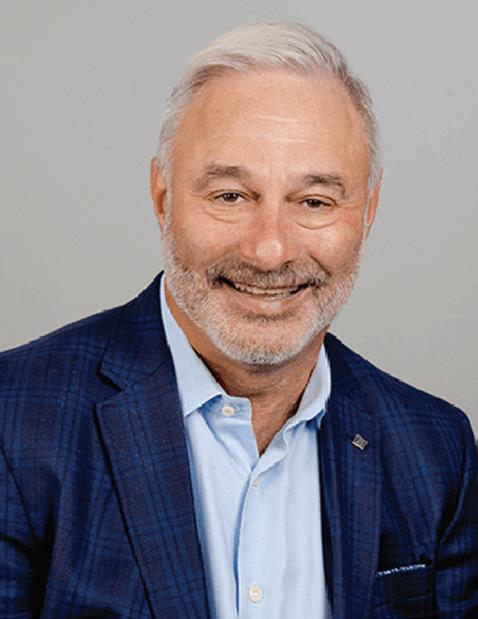



The biggest player in the state, by a long shot, is Diamond Baseball Holdings, which owns 41 of the 120 minor league teams affiliated with Major League Baseball. Its Tar Heel state holdings are the Triple-A Charlotte Knights, where players regularly shuttle back and forth to the majors, along with the Winston-Salem Dash, and Hickory Crawdads, both Single-A franchises. They also own the former Kinston franchise that Diamond Baseball moved to Spartanburg, South Carolina, shortly after acquiring it in 2023.
Diamond has invested more than $2 billion in minor league baseball since its formation four years ago, and it isn’t stopping. Their plan is to reach the 50-team cap on franchise ownership by a single entity, while boosting profit through efficiencies and associated development.
The business is a subsidiary of private-equity giant Silver Lake Technology Partners, which has $103 billion of assets under management. Dan Rajkowski, the Knights’ executive vice president, says his new bosses are pouring resources into the franchise, improving ticketing, accounting systems and analytics.
“I’m the old school baseball guy and I thought we were doing things OK,” says Rajkowski, a holdover from the former owner with 41 years of baseball experience. “But, we weren’t current. We were trying to catch up, but it was going slowly. As this settles, it’s
really going to be great for baseball here.”
While corporate money has moved in, ownership of North Carolina’s teams is still a mixed bag.
The Class A Asheville Tourists are owned by the Dewine family, which includes Ohio’s governor, Mike DeWine. His son Brian, a Clemson University grad and an Asheville resident for 15 years, is the team president.
“[Diamond] is there, but you have lots of other smart companies and individuals doing this, too. It’s thriving and it's fun,” he says.
The Durham Bulls, the icon of minor league baseball’s resurgence in the 1980s and 1990s, are owned by Capitol Broadcasting of Raleigh. Two other North Carolina teams, the Fayetteville Woodpeckers and the Carolina (Zebulon) Mudcats, are owned by the Major League teams with which they are affiliated. The Mudcats are moving 25 miles east to the new $67 million Wilson Sports and Entertainment complex in 2026.


The High Point Rockers, an independent league team created in 2019, is a unique case, with no affiliation with the majors. It assembles its own roster and salaries max out at $3,000 per month under league rules. Most players are looking for a final shot at Big League glory or just playing out the string in the game they love.
The Rockers are a nonprofit controlled by the High Point Downtown Stadium Foundation, a 501(c)(3) charged with “operating for the public benefit, the public-owned sports, entertainment and community events facility in downtown High Point.” It operates the team and the city-owned Truist Point Stadium.







North Carolina is a hot baseball market because of its temperate climate, large number of right-sized cities and a long tradition. The Tar Heel state has hosted minor league teams since the late 19th century, and was home to 49 minor league teams at its peak in the 1940s. Snow Hill, a crossroads burg of 1,600 in rural Greene County, once had a team.
“Every city in North Carolina with a stoplight, they had a minor league team,” says Pete Fisch, president of the High Point Rockers and a 30-year industry veteran. “It’s a sports-based state in general, so lots of tradition.”
The business of baseball is still mostly about getting people out to the old ballpark. Minor league baseball is the second-most attended sporting event in America (behind only Major League Baseball), thanks to the sheer volume of the games and long standing as a summer tradition.
Why people come to a game has changed over time. What’s happening on the field is hardly the only driver.
The Winston-Salem Dash crew more than 255,000 fans last season, and President Brian DeAngelis divides his ticket buyers into three roughly equal groups: real baseball people who often buy season tickets; groups who come to games for an outing; and casual fans who attend every now and then, mostly as a social event.


That breakdown is consistent throughout minor league baseball, he says, although some of the most successful franchises in the largest minor league markets tend to lean more on “social fans” and game-day sales.
Now you know why minor league baseball turns into a three-ring circus at times. Between innings, fans see an assortment of silly contests such as putting on frozen T-shirts or bouncing off each other in inflatable “sumo wrestler” suits.
“Special nights” are important lures, and increasingly odd. Teams have given away toilets, liposuction treatment, and even the recently removed gall bladder of a team’s GM.
Asheville has a “Hippie” night, in which both players and fans dress in their tie-dyed best.
In Winston-Salem, the Dash rebranded themselves as the “Hype Hens” for a night last year, complete with new uniforms and logos, chicken dancing in the aisles and a chicken coop in the outfield. The special night was a dig at the “controversy” over the correctness of the team’s name: Is the punctuation in Winston-Salem a dash or a hyp(e)-hen?
“Most of the promotions don’t have much to do with baseball,” says DeAngelis. “I’m sure that drives some people crazy, but for most people it makes the night more interesting.”





Corporate ownership is increasing pressure to produce profits. Driving baseball ticket sales is one answer to that squeeze, but keeping prices affordable is critical, given the Everyman target that most teams seek.
Most franchises have turned to non-baseball events to supplement the summer action. Some are rentals; who wouldn’t want to be married or buried at the ballpark?
But other events offer different entertainment at venues equipped with seating, public restrooms and concession stands. The Charlotte Knights now gather more than 20% of its revenue from non-baseball events. It hosted a 30-night Winter/Christmas festival with an ice skating rink, snow-tubing hill, food, music, Santa and thousands of Christmas lights. About 150,000 showed up, including a facility-record crowd of 11,000 attending a minorleague hockey game.
When a $40 million renovation is complete at 101-year-old McCormick Field in Asheville next year, the team will host a series of fall concerts. That’s part of its agreement with the city, county and tourism authority. The later three are funding most of the renovations.
Greensboro hosts a beach music night on Thursdays when the Grasshoppers are not in town. Following a $9.8 million renovation, High Point shares the field with the Core FC, a minor league soccer team.
In Winston-Salem, the Dash packed the stadium for a Drone light show, which took some fortitude by its new owner — Diamond Baseball. “The show is expensive,” says DeAngelis, a holdover from the previous owner’s management team. “We (the Dash) couldn’t afford the risk (i.e., the insurance cost) on our own.”
The Dash’s Truist Stadium, overlooking old I-40 not far from downtown, is also host to smaller fare, like a prom for special needs kids and quilting club that meets monthly to patch things up. That group doesn’t pay much, but DeAngelis calls it a way to support the community.










The biggest dollar signs in minor league baseball are attached to real estate development. Almost every N.C. franchise has wrangled a new or renovated stadium because local leaders believed a baseball park would be an attractive amenity. Most are located in or near downtown areas undergoing renovation. High Point’s Truist Point is a cornerstone, with the Congdon Yards office and event space, of a new downtown area that is known as “The Catalyst.”
The actual catalytic effect is unclear.
During negotiations on stadium renovations with municipal officials, the Asheville Tourists commissioned a study that showed a $9.8 million primary economic impact for the city. Charlotte Center City Partners says the Knights contribute about $46.7

Minor league baseball is a hot commodity right now, after being a much smaller business economically in the 1970s and ‘80s. As well as most teams are doing, it's still not impossible to screw it up.
Several years ago, the owners of the Gastonia independent league franchise went off the rails and wound up more than $4 million in debt. In early 2024, Jacksonville, Florida-based Zawyer Sports and Entertainment bought the franchise and paid its creditors. The business later bought a controlling interest in the Charlotte Checkers hockey franchise, and also owns the new Greensboro Gargoyles hockey team.
Industry leaders say their biggest worries are keeping fans interested, given the many options for spending time and cash.
million annually in economic activity, while about $1 billion of development has occurred around the ballpark over the past decade.
Other cities have made similar claims. Still, repeated academic studies show the benefit to the municipality is marginal, at best.
A paper published in 2022 in the Journal of Economic Studies notes that “recent analyses continue to confirm the decades‐old consensus of very limited economic impacts of professional sports teams and stadiums. … the large subsidies commonly devoted to constructing professional sports venues are not justified as worthwhile public investments.”
High Point’s Fisch says, “Look, this (the High Point ballpark and team) was built as an economic development tool. We try to make a little profit, and we do, but without (the team and the ballpark) we would not have the hotel opening (coming next year) and the bars and restaurants, Congdon Yards. All that revolves around the ballpark, and it has improved the quality of life.”
Teams in Charlotte and Greensboro own their stadiums and can be part of their own development bonanza. DBH is pondering a hotel and restaurant combo beyond its outfield fence in Charlotte, where the park sits on prime center-city real estate.
When Temerity purchased the ailing Kannapolis franchise in 2018, it hoped to own the new ballpark downtown. That didn’t happen, but Temerity did acquire development rights on several adjacent parcels. It’s partnered on a seven-story apartment tower down the right field line. The project includes the aptly named Towel City Tavern, plus the team’s apparel shop and offices. A hotel project might fill in the left field line some day.
“Margins for baseball remain thin,” says Temerity’s Brown. “The real money is the development and the long-term addition of value.”
“This is a great market — a lot of places in North Carolina are,” says High Point’s Fisch. “But the competition is fierce for the entertainment dollar. Folks in the Triad and North Carolina are spoiled. There’s lots to do around here. For us, within 15 miles, there are two Class A ball clubs, two professional hockey teams, professional soccer, and then (NC) State, (North) Carolina-Wake (Forest), Duke, High Point University … And an hour or so away you can go see the Hornets, Panthers, or Hurricanes, if you want to spend a little more. Within a landscape like that, it can be hard to find a place.”
Asheville’s DeWine is looking forward to a renovated park on the side of a mountain in the trendy South Slope Brewing District. He thinks McCormick Field’s newly digitized digs can help drive attendance north of 200,000 per season in future years. He also knows he can’t lose touch with the past.
Ty Cobb played in the opener at McCormick a century ago. Babe Ruth, passing through, called the park, “an absolute delight.”

“People still come here, from everywhere, just because it is old, it is a part of baseball tradition. It’s not some cookie-cutter place. My family and I love it,” says DeWine. “Baseball is like that. It’s something that has pulled people together in this country, this state, and this town for a long time.
“This team, it is a labor of love. Trust me, if you don’t love baseball you would not be doing this.”

The PGA Championship highlights another big year for North Carolina golf. Here are the state’s best courses.
By Brad King and Kevin Ellis




For the second consecutive year, the best golfers in the world will meet in North Carolina. Last year, it was the famed Pinehurst No. 2 golf course playing host to the U.S. Open for the first time since 2014. In May, it will be the PGA Championship at Quail Hollow Club in Charlotte, where that tournament was last held in 2017.
North Carolina’s diverse geography, from the coast to the mountains, as well as moderate temperatures, make it well suited for major golf tournaments, along with everyday players. The Tar Heel state ranks eighth in the nation in the number of golf courses with 549. The game generates $2.3 billion in direct spending and a total economic impact of $4.2 billion in the state, including about 53,000 jobs, according to the state.
Last year’s U.S. Open generated $242.5 million in economic impact for the state, according to a study by the United States Golf Association. The PGA Championship is expected to provide more than a $100 million boost to Charlotte’s economy, with as many as 50,000 golf fans expected to attend the tournament each day.
Those are just dollars though, says Johnny Harris, the Charlotte real estate executive who is the president of Quail
Hollow Club. Global media exposure also will enhance Charlotte’s reputation as a premier destination for major sporting events and business opportunity, he says.
“When people all over the world tune into a major golf championship and they do, it’s not Charlotte, North Carolina, it’s just Charlotte now,” he says.
North Carolina will be a destination for major golf tournaments for years to come, including four more U.S. Open Championships at Pinehurst through 2047, the U.S. Women’s Open at Pinehurst in 2029, the Wyndham Championship in Greensboro and Truist Championship (formerly Wells Fargo) in Charlotte. Each event is televised internationally, showcasing the state.
The North Carolina Golf Panel celebrates the sport with its 30th annual ranking of the state’s best courses, which debuts in this magazine. About 175 business executives, golf industry members and media members rate the courses spanning the state.
While there are limited changes from year to year, four courses in the Top 10, moved up in the rankings: Quail Hollow, Old Town Club in Winston-Salem, Sedgefield Country Club in Greensboro and Pinehurst No. 4. Eight courses are new to this year’s list, including Pinehurst No. 10, which opened last April.


Ranked by the North Carolina Golf Panel, comprised of golf aficionados from around the state. The second number is the previous year’s ranking.
1. 1. PINEHURST NO. 2
PINEHURST
72 7,588 76.5/138
Par Yardage Course rating/slope
2. 2. GRANDFATHER GOLF AND COUNTRY CLUB LINVILLE
7,085 74.3/145
3. 3. THE COUNTRY CLUB OF NORTH CAROLINA (DOGWOOD)
PINEHURST 72 7,204 75.2/134
4. 5. QUAIL HOLLOW CLUB
CHARLOTTE 72 7,396 75.0/140
5. 4. PINE NEEDLES LODGE AND GOLF CLUB SOUTHERN PINES 71 7,015 73.5/135
6. 6. ELK RIVER CLUB BANNER ELK 72 6,826 73.4/141
7. 8. OLD TOWN CLUB
WINSTON-SALEM 70 7,037 74.4/138
8. 9. SEDGEFIELD COUNTRY CLUB
GREENSBORO 71 7,117 72.9/130
9. 10. OLD CHATHAM GOLF CLUB DURHAM
7,247 75.3/140
10. 11. PINEHURST NO. 4 PINEHURST
7,227 74.9/138
11. 15. OLD NORTH STATE CLUB NEW LONDON 72 7,166 75.4/151
12. 12. THE COUNTRY CLUB OF NORTH CAROLINA (CARDINAL)
PINEHURST 72 7,212 75.0/141
13. 7. MOUNTAINTOP GOLF AND LAKE CLUB CASHIERS
7,126 73.9/145
14. -- PINEHURST NO. 10 PINEHURST
7,020 74.1/142
15. 14. CAPE FEAR COUNTRY CLUB WILMINGTON 72 7,005 74.3/139
16. 13. PINEHURST NO. 8 PINEHURST
7,099 74.1/137
17. 16. CHARLOTTE COUNTRY CLUB CHARLOTTE
7,335 75.9/146
18. 17. RALEIGH COUNTRY CLUB RALEIGH
7,394 75.9/143
19. 22. FORSYTH COUNTRY CLUB
WINSTON-SALEM 71 6,784 72.0/136
20. 18. EAGLE POINT GOLF CLUB WILMINGTON 72 7,170 74.5/137
21. 20. RIVER LANDING (RIVER) WALLACE 72 7,009 74.1/141
22. 19. MACGREGOR DOWNS COUNTRY CLUB CARY 72 7,003 73.4/134
23. 25. ROCK BARN COUNTRY CLUB (JONES) CONOVER 72 7,126 74.4/141
24. 26. GOVERNORS CLUB
CHAPEL HILL 72 7,062 75.1/144
25. 21. MID PINES INN AND GOLF CLUB
SOUTHERN PINES 72 6,732 71.0/126
26. 23. COUNTRY CLUB OF LANDFALL (DYE) WILMINGTON 72 7,026 74.3/132


27. 24. DORMIE CLUB
6,927 73.7/138
28. 27. COUNTRY CLUB OF LANDFALL (NICKLAUS) WILMINGTON
7,100 75.7/144
29. 35. TREYBURN COUNTRY CLUB DURHAM
7,175 74.1/137
30. 29. BILTMORE FOREST COUNTRY CLUB
6,606 71.5/127
31. 30. STARMOUNT FOREST COUNTRY CLUB
6,728 72.7/140
32. 31. RIVER LANDING (LANDING) WALLACE
7,112 74.2/134
33. 28. PRESTONWOOD COUNTRY CLUB (HIGHLANDS)
7,082 74.4/138
34. 34. CHAMPION HILLS CLUB HENDERSONVILLE
6,510 71.7/144
35. 33. PINEHURST NO. 9
7,125 75.1/143
36. 32. FOREST CREEK GOLF CLUB (SOUTH) PINEHURST
7,067 74.6/143
37. 36. THE CLUB AT LONGVIEW WAXHAW 72 7,065 74.5/140
38. 37. MID SOUTH CLUB
SOUTHERN PINES 71 7,003 73.8/144
39. 39. FOREST CREEK GOLF CLUB (NORTH) PINEHURST
7,139 74.7/144
40. 40. MYERS PARK COUNTRY CLUB CHARLOTTE
7,120 74.3/138
41. 42. BRYAN PARK (CHAMPIONS) BROWNS SUMMIT 72 7,255 75.4/140
42. 48. OCCANO MERRY HILL
7,257 76.3/139
43. 38. LINVILLE GOLF CLUB LINVILLE
6,946 73.4/139
44. 44. HIGH POINT COUNTRY CLUB (WILLOW CREEK)
6,972 73.9/139
45. 45. GREENSBORO COUNTRY CLUB (FARM) GREENSBORO
7,302 75.1/140
46. 46. GRANDOVER (EAST) GREENSBORO 72 7,270 75.7/141
47. 47. FINLEY GOLF COURSE CHAPEL HILL 72 7,223 74.9/138
48. 41. TRUMP NATIONAL GOLF CLUB MOORESVILLE
7,037 74.2/140
49. 49. PINEHURST NO. 7 PINEHURST
7,216 75.5/143
50. 51. FOREST OAKS COUNTRY CLUB GREENSBORO
7,212 74.7/141
51. 50. HOUND EARS CLUB BOONE
6,327 69.9/129
52. 52. LONNIE POOLE GOLF COURSE RALEIGH 72 7,358 74.4/142
53. -- WAYNESVILLE INN & GOLF CLUB WAYNESVILLE
6,515 71.5/139



54. 53. COUNTRY CLUB OF ASHEVILLE ASHEVILLE 71 6,672 72.3/134
55. 62. BALLANTYNE COUNTRY CLUB CHARLOTTE 72 7,034 74.1/136
56. 56. DUKE UNIVERSITY GOLF CLUB DURHAM
7,105 73.9/141
57. 55. THE CARDINAL BY PETE DYE GREENSBORO 70 6,821 74.2/139
58. 54. THE HASENTREE CLUB WAKE FOREST
7,074 73.9/139
59. 58. MIMOSA HILLS GOLF CLUB MORGANTON
6,750 72.8/137
60. 59. PORTERS NECK COUNTRY CLUB WILMINGTON
7,112 74.8/138
61. 57. BALD HEAD ISLAND CLUB BALD HEAD ISLAND 72 6,855 73.7/143
62. -- THE CLUB AT 12 OAKS HOLLY SPRINGS 72 7,093 75.0/146
63. 61. THE CURRITUCK CLUB COROLLA
6,888 73.9/136
64. 64. PINEWOOD COUNTRY CLUB ASHEBORO
6,830 73.5/134
65. 65. CAROLINA COUNTRY CLUB RALEIGH 71 6,304 70.7/138
66. 60. GASTON COUNTRY CLUB
GASTONIA 72 7,042 74.2/135
67. 68. CEDARWOOD COUNTRY CLUB
CHARLOTTE
71 6,940 73.9/137
68. 63. HOPE VALLEY COUNTRY CLUB
DURHAM 70 6,671 73.1/133
69. 66. PRESTONWOOD COUNTRY CLUB (MEADOWS)
CARY
72 7,108 74.6/138
70. 69. SOUTHERN PINES GOLF CLUB
SOUTHERN PINES 71 6,354 70.2/129
71. 70. HIGH MEADOWS COUNTRY CLUB
HIGH MEADOWS 72 6,698 72.1/130
72. 71. GRANDOVER (WEST)
GREENSBORO
6,800 72.5/136
73. 73. BLOWING ROCK COUNTRY CLUB
BLOWING ROCK
6,162 69.9/130
74. SPRINGDALE RESORT
CANTON
6,969 73.0/134
75. 67. PINEWILD COUNTRY CLUB (MAGNOLIA)
PINEHURST
7,446 76.4/139
76. 72. CROW CREEK GOLF CLUB
CALABASH 72 7,101 73.9/130
77. 74. CROASDAILE COUNTRY CLUB
DURHAM
7,068 73.4/140
78. 77. TALAMORE GOLF RESORT
SOUTHERN PINES 71 6,840 73.2/140
79. 75. ALAMANCE COUNTRY CLUB
BURLINGTON
6,900 72.8/128
80. -- KENMURE COUNTRY CLUB
FLAT ROCK 72 6,509 71.4/143
81. 84. CARMEL COUNTRY CLUB (SOUTH)
CHARLOTTE
7,503 76.5/142



82. 89. KILMARLIC GOLF CLUB
POWELLS POINT
72 6,560 72.2/144
83. 82. PROVIDENCE COUNTRY CLUB
CHARLOTTE
72 7,021 74.6/141
84. 85. MILL CREEK GOLF CLUB
MEBANE
72 7,004 73.5/144
85. 76. BRIGHT’S CREEK CLUB MILL SPRING 72 7,392 76.1/143
86. 79. JEFFERSON LANDING JEFFERSON 72 7,111 73.1/134
87. 80. THE CLUB AT IRISH CREEK KANNAPOLIS
72 7,099 74.3/137
88. -- MOORESVILLE GOLF CLUB
MOORESVILLE
72 6,803 73.0/135
89. 86. TANGLEWOOD PARK (CHAMPIONSHIP) CLEMMONS
70 7,101 74.6/140
90. 87. THISTLE GOLF CLUB SUNSET BEACH
71 6,898 74.1/135
91. 78. LEOPARD’S CHASE SUNSET BEACH
72 7,055 74.3/140
92. 88. CRYSTAL COAST COUNTRY CLUB PINE KNOLL SHORES
6,005 69.7/127
93. 90. LINVILLE RIDGE LINVILLE
6,775 72.8/136
94. 91. THE COUNTRY CLUB AT WAKEFIELD PLANTATION
7,257 75.2/137
95. TOT HILL FARM ASHEBORO
6,713 72.8/146
96. 92. BROOK VALLEY COUNTRY CLUB
6,836 73.8/141
97. 94. DEEP SPRINGS COUNTRY CLUB
6,936 73.8/136 98. -- LONGLEAF GOLF & FAMILY CLUB SOUTHERN PINES
6,682 72.4/132 99. 97. MOREHEAD CITY COUNTRY CLUB
6,855 73.4/142
100. 98. BERMUDA RUN COUNTRY CLUB (EAST) BERMUDA RUN
7,045 74.3/139








Panelists’ top picks for the best public and semi-private courses in the state.
1. PINEHURST NO. 2 PINEHURST 72 7,588
2. PINE NEEDLES LODGE AND GOLF CLUB SOUTHERN PINES 71 7,015
3. PINEHURST NO. 4 PINEHURST 72 7,227
4. PINEHURST NO. 10 PINEHURST 70 7,020
5. PINEHURST NO. 8 PINEHURST 72 7,099
6. MID PINES INN AND GOLF CLUB SOUTHERN PINES 72 6,528
18. THE CARDINAL BY PETE DYE GREENSBORO 70 6,821

7. PINEHURST NO. 9 PINEHURST 72 7,125

8. MID SOUTH CLUB SOUTHERN PINES 71 7,003
9. BRYAN PARK (CHAMPIONS) BROWNS SUMMIT 72 7,255
10. OCCANO MERRY HILL 72 7,257
11. GRANDOVER (EAST) GREENSBORO 72 7,270
12. FINLEY GOLF COURSE CHAPEL HILL 72 7,223
13. PINEHURST NO. 7 PINEHURST 72 7,216
14. FOREST OAKS COUNTRY CLUB
7,212
15. LONNIE POOLE GOLF COURSE RALEIGH
16. WAYNESVILLE INN & GOLF CLUB
6,515

19. THE CURRITUCK CLUB COROLLA 72 6,888
20. SOUTHERN PINES GOLF CLUB SOUTHERN PINES 71 6,354
21. GRANDOVER (WEST) GREENSBORO 72 6,800
22. SPRINGDALE RESORT CANTON 72 6,969
23. CROW CREEK GOLF CLUB CALABASH 72 7,101
35. STONEY CREEK GOLF CLUB WHITSETT 71 7,016

24. TALAMORE GOLF RESORT SOUTHERN PINES 71 6,840
25. KILMARLIC GOLF CLUB POWELLS POINT
6,560
26. MILL CREEK GOLF CLUB MEBANE
7,004
27. MOORESVILLE GOLF CLUB MOORESVILLE
6,803
28. TANGLEWOOD PARK (CHAMPIONSHIP) CLEMMONS
7,101
29. THISTLE GOLF CLUB SUNSET BEACH 71 6,898

7,105
36. OAK VALLEY GOLF CLUB ADVANCE 72 7,033
37. TIGER’S EYE SUNSET BEACH 72 6,849
38. RUMBLING BALD RESORT (APPLE VALLEY) LAKE LURE 72 6,625
39. CYPRESS LANDING GOLF COURSE CHOCOWINITY 72 6,851

40. CUTTER CREEK GOLF CLUB SNOW HILL 72 7,280
41. WILDWOOD GREEN GOLF CLUB RALEIGH 70 6,473

30. LEOPARD’S CHASE SUNSET BEACH 72 7,055
31. CRYSTAL COAST COUNTRY CLUB PINE KNOLL SHORES 70 6,005
32. TOT HILL FARM
6,713
33. DEEP SPRINGS COUNTRY CLUB
6,936
34. LONGLEAF GOLF & FAMILY CLUB SOUTHERN PINES
6,682
42. ROCK BARN COUNTRY CLUB (JACKSON) CONOVER 71 6,427
43. ROCKY RIVER GOLF CLUB CONCORD 72 6,970
44. PINEHURST NO. 6 PINEHURST 72 7,053
45. TOBACCO ROAD GOLF CLUB SANFORD 71 6,554
46. NAGS HEAD GOLF LINKS NAGS HEAD 71 6,126


47. CAROLINA COLOURS GOLF CLUB NEW BERN 72 7,008
48. BRYAN PARK (PLAYERS) BROWNS SUMMIT 72 7,057
49. LEGACY GOLF LINKS ABERDEEN 72 7,004
50. THE CAROLINA CLUB GRANDY 72 6,697


1. Cape Fear Country Club, Wilmington
2. Eagle Point Golf Club, Wilmington
3. Country Club of Landfall (Dye), Wilmington
4. Country Club of Landfall (Nicklaus), Wilmington
5. Bald Head Golf Club, Bald Head Island
6. Porters Neck Country Club, Wilmington
7. The Currituck Club , Corolla
8. Crow Creek Golf Club, Calabash
9. Kilmarlic Golf Club, Powells Point
10. Thistle Golf Club, Sunset Beach
11. Leopard’s Chase, Sunset Beach
12. Crystal Coast Country Club, Pine Knoll Shores


1. Quail Hollow Club, Charlotte
2. Charlotte Country Club, Charlotte
3. The Club at Longview , Waxhaw
4. Myers Park Country Club, Charlotte
5. Trump National Golf Club , Mooresville
6. Ballantyne Country Club, Charlotte
7. Gaston Country Club, Gastonia
8. Cedarwood Country Club , Charlotte
9. Carmel Country Club (South), Charlotte
10. Providence Country Club, Charlotte
11. The Club at Irish Creek, Kannapolis
12. Mooresville Golf Club, Mooresville

1. River Landing (River), Wallace
2. River Landing (Landing), Wallace
3. Occano, Merry Hill
4. Brook Valley Country Club, Greenville
5. Benvenue Country Club, Rocky Mount
6. Greenville Country Club, Greenville
7. Cypress Landing Golf Course, Chocowinity
8. Cutter Creek Golf Club, Snow Hill
9. Carolina Colours Golf Club, New Bern
10. Wilson Country Club, Wilson
11. Highland Country Club, Fayetteville
12. Walnut Creek Country Club, Goldsboro
1. Old Town Club, Winston-Salem
2. Sedgefield Country Club, Greensboro
3. Old North State Club, New London
4. Forsyth Country Club, Winston-Salem
5. Starmount Forest Country Club, Greensboro
6. Bryan Park (Champions), Browns Summit
7. High Point Country Club (Willow Creek), High Point
8. Greensboro Country Club (Farm), Greensboro
9. Grandover Resort (East), Greensboro
10. Forest Oaks Country Club, Greensboro
11. The Cardinal by Pete Dye, Greensboro
12. Pinewood Country Club, Asheboro
1. Pinehurst No. 2, Pinehurst
2. The Country Club of North Carolina (Dogwood), Pinehurst
3. Pine Needles Lodge and Golf Club, Southern Pines
4. Pinehurst No. 4, Pinehurst
5. The Country Club of North Carolina (Cardinal), Pinehurst
6. Pinehurst No. 10, Aberdeen
7. Pinehurst No. 8, Pinehurst
8. Mid Pines Inn and Golf Club, Southern Pines
9. Dormie Club, West End
10. Pinehurst No. 9, Pinehurst
11. Forest Creek Golf Club (South), Pinehurst
12. Mid South Club, Southern Pines


1. Old Chatham Golf Club, Durham
2. Raleigh Country Club, Raleigh
3. MacGregor Downs Country Club, Cary
4. Governors Club, Chapel Hill
5. Treyburn Country Club, Durham
6. Prestonwood Country Club (Highlands), Cary
7. Finley Golf Course, Chapel Hill
8. Lonnie Poole Golf Club, Raleigh
9. Duke University Golf Club, Durham
10. The Hasentree Club, Wake Forest
11. The Club at 12 Oaks, Holly Springs
12. Carolina Country Club, Raleigh
1. Grandfather Golf and Country Club, Linville
2. Elk River Club, Banner Elk
3. Mountaintop Golf and Lake Club, Cashiers
4. Rock Barn Country Club (Jones), Conover
5. Biltmore Forest Country Club, Asheville
6. Champion Hills Club, Hendersonville
7. Linville Golf Club, Linville
8. Hound Ears Club, Boone
9. Waynesville Inn & Golf Club, Waynesville
10. Country Club of Asheville, Asheville
11. Mimosa Hills Golf Club, Morganton
12. Blowing Rock Country Club, Blowing Rock


(Play the Jackson Course, Ranked #3 by GOLFPASS for Layout)

Treat the team and yourself to an outing you’ll never forget. Rock Barn Country Club and Spa nestled in the foothills of North Carolina, offers something for everyone. From fairways to spa days its central location and diverse amenities make it an ideal place for your next outing. To book, call or email: (828) 459-1125 / reception@rockbarn.com










PGA Championship returns to Charlotte in 2025; annual Truist Championship heads north.
By Brad King
he world’s best golfers will converge on Charlotte when the Queen City plays host to one of the sport’s most prestigious events: the PGA Championship, contested this year from May 1518 at Quail Hollow Club.
Hosting this major championship is projected to infuse more than $100 million into Charlotte’s economy. The influx of visitors will benefit hotels, restaurants and retail establishments, while the global media exposure will further enhance Charlotte’s reputation as a premier destination for major sporting events.
“When people all over the world tune into a major golf championship and they do, it’s not Charlotte, North Carolina, it’s just Charlotte now,” says Johnny Harris, also chair and former CEO of commercial real estate firm Lincoln Harris.
“This is a place that brings people together with sports, and what greater way to do that than (the PGA Championship),” Harris says.
Established in 1959 in Charlotte’s SouthPark neighborhood, Quail Hollow Club boasts a championship pedigree that few courses in the Southeast can rival. The club became known for hosting the annual Wells Fargo Championship, recently rebranded as the Truist Championship following a seven-year title sponsorship agreement announced in August 2024.

Quail Hollow first hosted the PGA Championship in 2017, marking North Carolina’s inaugural experience with one of the PGA Tour’s four major tournaments. Justin Thomas captured his first major title and the event was a resounding success, drawing more than 200,000 fans and generating an estimated $128 million in economic impact (adjusted for inflation).
Quail Hollow also played host to the Presidents Cup in 2022, which delivered a record-setting $131.5 million


economic impact for Charlotte as Team USA triumphed in front of energetic crowds in the biennial international competition.
To accommodate the 2025 PGA Championship at Quail Hollow, this year’s Truist Championship will temporarily relocate to the Philadelphia Cricket Club’s Wissahickon Course.
The last time such a move occurred was in 2017 when the Wells Fargo Championship relocated to Eagle Point Golf Club in Wilmington, while Quail Hollow prepared for the PGA.
The move that year provided a financial boost to North Carolina’s largest coastal city, while also presenting a number of logistical challenges.
In search of a larger and more lucrative market, the 2025 event heads north to Pennsylvania. The one-year hiatus tees up a dual narrative: While the PGA Championship’s economic infusion is significant, the loss of the Truist Championship for a year presents more than just a minor inconvenience, as an important local economic driver is temporarily relocated out of state.
The tournament, a staple on the PGA Tour calendar, typically generates $40-50 million in direct and indirect spending each year, providing temporary employment and generating business for vendors supplying food, merchandise and event infrastructure. In 2025, these jobs and contracts will be shifted to Philadelphia businesses.
In addition, historically, the event has raised millions for North Carolina-based charities. This year, these contributions will primarily benefit organizations near Philadelphia Cricket Club.
Still, the PGA Championship at Quail Hollow Club promises to deliver global visibility and substantial financial benefits, while showing the N.C. golf industry’s resiliency. ■




A trio of Triangle companies play a muscular role in the golf apparel and equipment trade.
By Brad King






North Carolina has long been a golf-rich state, home to legendary courses, major tournaments and a deeply rooted golf culture. These days, beyond the fairways, the Triangle region has emerged as a hub for golf and lifestyle apparel, housing some of the industry’s most recognized brands.
Three companies — Peter Millar, Stitch Golf and Johnnie-O — have set up significant operations in the Triangle where they contribute to job creation, economic growth and the state’s reputation as a center for premium golf apparel and equipment.
Peter Millar’s headquarters and distribution hub anchor its global business in the region, while Stitch Golf’s Cary base has positioned it as a leader in premium golf accessories. Johnnie-O has embraced Raleigh as its East Coast headquarters.


The Triangle’s appeal to these brands extends beyond location. Access to talent, a strong golf market, and a business-friendly climate have helped drive growth. As Peter Millar CEO Scott Mahoney puts it: “Raleigh offered us the ability and place to have a history and a home … It’s a great city with a strong undercurrent of young people, great architecture and a welcoming community.”
With global ambitions but local roots, this trio of brands highlights North Carolina’s increasing influence in the golf and lifestyle apparel industry.





Founded: 2001
Headquarters: Raleigh
Key Offerings
Golf Apparel:
Moisture-wicking polos, technical quarter-zips and breathable outerwear
Tailored Clothing: Luxury dress shirts, blazers, and trousers in premium fabrics
Casual Wear: Soft-knit sweaters, performance tees and refined denim
Footwear & Accessories: Leather shoes, belts and travel bags




Founded in 2001 by Raleigh entrepreneur Chris Knott, Peter Millar started with a single cashmere sweater and quickly became a leader in luxury golf and lifestyle apparel. Today, the company operates corporate offices in Raleigh and an 80,000-square-foot distribution hub in Durham, selling a full range of golf, casual and dress apparel worldwide.
Peter Millar’s brand blends traditional tailoring with modern performance fabrics, creating apparel that is equally suited for the golf course, the office and travel. Its collections feature moisture-wicking polos, four-way stretch trousers and wrinkle-resistant blazers, providing a mix of function and sophistication.


CEO Scott Mahoney, a former Polo Ralph Lauren executive, joined Peter Millar in 2005 and has overseen its transformation from a niche golf apparel brand to a global luxury powerhouse. Under Mahoney’s leadership, Peter Millar expanded its wholesale distribution, launched a thriving direct-to-consumer business and opened retail stores in key markets, including a flagship store in midtown Manhattan in New York City.
Since 2012, Peter Millar has been owned by Swiss luxury conglomerate Richemont, which is the parent company of Cartier, Montblanc, Chloe and other brands. While the acquisition provided Peter Millar with expanded resources and international exposure, the company has remained headquartered in the Triangle and stayed due to its founding vision. A Richemont financial report cites Peter Millar as one of its companies with “continued outperformance.”
Peter Millar’s growth strategy includes exclusive partnerships with high-end retailers, including Neiman Marcus, Nordstrom, and premier golf clubs. The company is the official outfitter of the United States Golf Association and U.S. Open Championship and outfits PGA Tour golfers Cameron Young and Thirston Lawrence. The brand’s appeal extends beyond golfers, resonating with business executives, travelers and style-conscious consumers.

Founded: 2005
Headquarters: Santa Monica, CA (East Coast HQ: Raleigh)
Key Offerings
Performance Polos: Stretch, moisture-wicking fabrics for active wear
Quarter-Zips & Outerwear: Lightweight layers for transitional weather
Casual Apparel: Button-downs, hybrid shorts, and relaxed chinos
Licensed Sportswear: NCAA, MLB, and NHL collaborations
Founded in 2005 by John O’Donnell, Johnnie-O has carved a niche in the lifestyle apparel market, blending Southern California’s laid-back style with classic East Coast prep. What began with polo shirts and quarter-zips quickly evolved into a full lifestyle brand, catering to golfers, travelers and professionals who seek a refined yet relaxed wardrobe.
While headquartered in Santa Monica, California, Johnnie-O has developed strong ties to Raleigh, where it has its East Coast headquarters, design center and first retail store
in North Hills. Raleigh native Chris Knott, the founder of Peter Millar, is the brand’s chief merchandising officer, overseeing product development and expansion efforts. In 2022, it received an investment of $108 million from Wasatch Global Investors and Ares Management Corp., which acquired minoirity stakes. Fourteen individuals also invested $48 million in the company in the same year, according to an SEC filing.



Johnnie-O’s growth strategy is built on a multi-channel approach, combining direct-to-consumer sales, strategic wholesale partnerships, and a strong presence in golf and resort retail. The brand has become a staple in private clubs, specialty boutiques and high-end resorts, while also expanding into college and professional sportswear. It has a major presence at Duke University’s campus store.
A key driver of Johnnie-O’s success has been its sports licensing program, which includes agreements with more than 200 universities, Major League Baseball and the NHL. The brand’s NCAA and MLB collections have seen double-digit e-commerce growth, fueling further expansion into licensed sports apparel.
Under the leadership of CEO Dave Gatto, an executive with a background in premium lifestyle brands, Johnnie-O continues to expand its retail and direct-to-consumer channels and innovate in the casual menswear space.



Founded: 2012
Headquarters: Cary
Key Offerings
Golf Bags: Lightweight, weather-resistant stand and travel bags
Headcovers: Leather covers in bold, modern designs
Performance Apparel: Moisture-wicking polos and stretch outerwear
Travel Gear: Durable, stylish duffels and backpacks
Founded in 2012, Stitch Golf began as a headcover brand before expanding into golf bags, travel gear and performance apparel. The Cary-based company has a reputation for clean design, technical innovation and premium materials, making it a staple in private clubs, high-end retailers and direct-toconsumer sales.
Founder Charlie Burgwyn, a PGA Class A professional, drew inspiration from vintage race cars, creating highquality accessories that merged style and function. Brad King, a Wake County native and entrepreneur, became CEO and board chair in 2017. (He’s not related to this story’s author.)
King was uniquely positioned to help drive Stitch forward. He had been Burgwyn’s golf coach at Apex High School and was a close friend and neighbor of Peter Millar founder Chris Knott. King’s background in business and retail, including the successful sale of his office supply company to Staples, made him the ideal leader to scale Stitch’s operations.
Under King’s leadership, Stitch has expanded into new product categories, strengthened its e-commerce platform, and grown its direct-to-consumer sales. Its SL1 Golf Bag, made from tour-grade synthetic leather, was named one of Golf Digest’s best stand bags, reinforcing its place in the high-end golf gear market.
Stitch remains privately held, backed by investors focused on premium lifestyle brands. The company reported receiving $3.6 million from 20 investors in 2021, and another $2.7 million from 18 investors in 2022. The brand continues to blend heritage styling with modern performance, helping shape the premium golf gear market and reinforcing the Triangle’s growing influence in the industry. ■








With the McConnell Golf network, you can tee off at 11 courses from the Blue Ridge Mountains to the Carolina coast, plus six premier properties throughout South Carolina, Tennessee, and Virginia. Experience championship golf, luxury amenities, and a vibrant club lifestyle — no matter where your journey takes you.
















Western N.C. golf courses battle to rebound from the hurricane’s strike.
t was almost a week and a half after Hurricane Helene before Peter Dejak set foot on Asheville Municipal Golf Course, which his company, Golf Partners, began managing two years earlier. As he took in the scene, FEMA workers and cadaver dogs painstakingly worked their way across the front nine buried by silt, in parts up to three feet deep.
Such was the devastation, with longstanding landmarks gone or unrecognizable. Dejak found himself asking, “What am I looking at? I didn’t know whether I was facing north or south,” he says. Even now, a full five months on, no one at “The Muni” really knows which way is up.
At issue is if, and when, FEMA funds will arrive allowing a complete rebuild of the front nine, which remains closed. Adding to the uncertainty is whether the city of Asheville will extend its own emergency funding to keep the elevated back nine, which suffered only tree loss, open in the meantime. An initial round of up to $250,000 to cover operational shortfalls expires at the end of March.
By Trent Bouts






Army Corps of Engineers cleared Asheville Municipal Golf Course of September’s storm debris in February. 6. The front nine at Asheville Municipal Golf Course sat buried for months beneath feet of silt dumped by a raging Swannanoa River
“The good thing is that everybody seems to understand the importance of the golf course historically, and its place in the community,” Dejak says. “It’s more than just a regular golf course.”
Designed by Donald Ross, when The Muni opened in 1927 it was the first municipal golf course in the state, later becoming the first racially integrated municipal course in the Southeast. Since 1959, it has hosted the SkyView Open, still one of the largest African American-operated tournaments in the country. In its own way, as a 2020 documentary by local filmmaker Paul Bonesteel portrayed, The Muni is a bit of a big deal.
Of course, an exponentially bigger deal was the loss of 106 lives in the state, and more than 100,000 homes destroyed or damaged during Helene. Against that backdrop, the fate of any golf course pales by comparison.
Even so, The Muni was one of dozens of courses across the foothills and mountains of Western North Carolina severely impacted by the storm. They may be recreation facilities, but each is an employer as well as a social hub, and at each, an economic and emotional toll has been exacted.


One golf course superintendent in the area admits to grappling with “survivor guilt.” He declined a phone interview but was poignant in a text: “A golf course and its infrastructure can be replaced — lives and generational property cannot. In this grand scheme of chaos, so many people lost things more precious and valuable...”
On top of the mountain Linville Ridge Country Club, the highest course east of the Mississippi, took the worst of the wind damage. There, development and operations director Steve Sheets put tree loss across the private development in the in the order of 10,000. So many fell on some homes, “you couldn’t even tell there was a house in there,” he says.
The public Sugar Mountain Golf Course in Banner Elk is one among a host of courses that will limp into the coming spring season. The course plans to reopen with a composite nine of its least affected holes mid-April, while the rest are repaired, with a tentative completion date mid-summer. The total repair bill, including reconstruction of 32 bunkers, the 16th green and significant tracts of cart paths, is expected to exceed $1.5 million.
Others, working to restore everything from greens to bridges, irrigation pumps and more, will take longer. Hound Ears Club in Boone is reclaiming significant portions of several holes that washed away and instead became a dumping ground for everything from propane tanks to RV campers.
Coming up with the money for the work is one thing. As Dejak says, “I don’t think anybody has had real success with FEMA so far. Some have gone to their insurance companies trying to get what they can, but most don’t have a lot of coverage for what was primarily flood damage. Most of the coverage involved was just for tree damage.”
Compounding the challenge is that, since the pandemic, play has gone through the roof, boosting demand for labor, services and equipment. To help those who needed it most, that meant, suspending the normal order of things and “Doing some things out of the box, just to get people to where they could function,” says Brent Miller, sales manager with Smith Turf & Irrigation, a Charlotte-based Toro distributor.
At a handful of courses, like Broadmoor Golf Links near Asheville Airport, Black Mountain Golf Club 30 minutes east and Mt. Mitchell Golf Club near Burnsville, the questions are existential.
The vast majority of employees who work at the region’s golf courses affected by the hurricane also live in communities that suffered extensive losses. Few could really clock off at the end of any day and the reality is that repairs will likely be done before the healing.
At least there was one step in the latter direction at Asheville Muni in February. The Army Corps of Engineers finally cleared the front nine of debris and, to be rid of hazardous contaminants, the top six inches of topsoil. It still doesn’t look like anything Dejak knew, but there is consolation in that it is no longer the same landscape where those cadaver dogs made several finds.
If, like Asheville Muni, the future of some mountain courses remains clouded and perhaps dependent on conversations with FEMA, there is little encouragement in the agency’s own data. Those numbers show that 43% of disaster-hit small businesses never reopen. Another 29% close shop within two years. ■






A pending deal has Jose Costa and Oaktree Capital poised to be the captains of car washing.
By David Mildenberg


If a newly clean car puts an extra bounce in one’s step, imagine the carom from taking over about 380 locations to become the global leader of car washes.
at’s the feeling Jose Costa enjoyed a er his privateequity-backed Express Wash Operations agreed to buy the U.S. car wash business of Charlotte’s Driven Brands for $385 million in February.
e combined rm will have 530 units and about 5,200 workers in 23 states, covering much of the Sunbelt and Michigan and Ohio in the Midwest.


“It’s one of the few times in the history of an industry that you see an opportunity like this when a very large platform goes to market,” says Costa, who joined Magnolia Wash Holdings as CEO in 2022 when the business had about 60 units. e transaction took about eight months to consummate. Final approval is expected by June 30.


With backing from Los Angeles-based Oaktree Capital Management since 2023, Costa rebranded Magnolia to the Whistle Express chain and formed a management team with new leaders in nance, marketing, operations and technology. Striking the Driven Brands deal a er eight months of pursuit followed acquisitions of about a dozen smaller companies over the past two years.



Costa is con dent that Whistle Express can achieve success that wasn’t in the cards for Driven Brands. It has been the second-largest operator of conveyor-style car washes, while also owning auto-service brands including Take 5 Oil Change, Meineke and Maaco.




But the car wash industry has been in a two-year rut a er various private-equity groups stormed into the industry, leading to a glut of locations as interest rates picked up and labor costs increased.
In February, Plano, Texas-based Zips Car Wash led for bankruptcy protection, seeking to slice $279 million in debt. It is one of the largest car wash operators with about 260 units under the Zips, Jet Brite and Rocket Express brands.
“ e whole industry in the last 12 to 24 months has seen pressure from the competitive intrusion,” Costa says. He predicts “a few more bankruptcies" because of high interest rates and high rents. Unpredictable weather conditions also can reduce tra c for lengthy periods, putting pressures on pro ts, he adds.
e 382 car car washes owned by Driven Brands posted revenue of $368 million in 2024, while the 720 independently owned locations contributed $212 million. at represented less than 10% of the company’s $6.9 billion in system-side sales last year. Company revenue totaled $2.3 billion, with the other $4.6 billion going to the franchise owners at Maaco, Take 5 Oil Change and other shops nationally.
Pro t margins declined at the car washes last year, while the company took a $325 million impairment charge, according to its annual report.
e good news, Costa says, is that the industry appears to be stabilizing, providing “a great opportunity to buy assets.”
His con dence stems from an insider’s edge. Costa worked at Driven for ve years, leading the Maaco business. He appeared on the CNBC network’s “Undercover Boss” in 2015 while leading the paint chain. Maaco reported 61 consecutive months of revenue growth during his tenure.
“We know the [car wash] assets better than anybody else,” he says, which helped during the bidding process conducted by Driven Brands. “We know the opportunities and how to x the problems. It becomes a capital allocation game in terms of where you put your money, which ones you rebrand, and how to improve the team and get the right technology.”
Costa is a native of Venezuela, where his father once led a leading ad agency. Amid that nation’s political turmoil, he moved to the U.S. in 2003 to attend graduate school in Chicago. Costa earned a master’s degree in integrated marketing communications from Northwestern University, then added an MBA at the University of


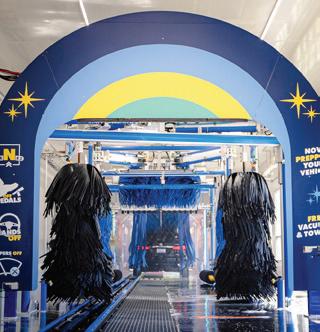

Chicago. He met his wife, Cindy, at Northwestern, and the couple have three children.
Like many marketing executives, Costa has moved around. A er stints at Burger King and Yum Brands, he moved to Maaco in 2013. Starting in 2017, he spent a year and a half as a senior North American executive at the French owner of the Luxottica and Ray-Ban eyewear brands. en, in 2019, he joined Charlotte-based Bojangles as chief development o cer and later, chief growth o cer, a er private-equity groups had acquired the publicly traded chain.
In May 2022 he moved from biscuits back to cars, seeing opportunity in the fragmented car wash industry.
Keys to making Whistle Express thrive are increasing the number of monthly memberships, which Costa says boosts visits by customers from perhaps four or six times a year to two or three stops per month. e car wash industry’s loyalty programs are behind airlines and other customer-facing industries, and Costa says he wants Whistle Express to catch up promptly.
Last fall, Driven Brands CEO Jonathan Fitzpatrick told investors the company had passed the 1 million mark in U.S. car wash memberships. He called it a “remarkable milestone.”
More washes means more wear and tear on the store equipment, of course. “ e number one priority is keeping the washes going, so that’s the number one investment, making sure you are up and running as much as possible.”
New locations require $5 million to $6 million of initial investment. “You need a lot of money to invest in equipment and infrastructure,” he says. e combined companies will have about 150 mechanics with necessary plumbing and mechanical skills.
One attraction of automated car washes is the relatively slim payroll. A site with $2 million in annual revenue can work with about ve sta ers, versus 20 or 30 at a fast-food restaurant, Costa says. Stores can open and close with two sta ers, then add more folks as business picks up during the day. “We’re always recruiting the best, and we’re competing against Target, Best Buy, McDonalds and others,” he says.
Costa’s 20-year career since leaving grad school has been marked by lots of challenges, none bigger than the current opportunity. “It’s the most fun I’ve had in my career. We have the right board and right team.”
Charlotte may deserve recognition as the nation’s conveyor car wash kingpin, not just because of Whistle Express’ pending purchase of Driven Brands’ units. The deal will make it the national leader in total units, ahead of Tucson, Arizona-based Mister Carwash, which has about 500 sites. It is owned by the Leonard Green and Partners private equity group.
But Charlotte is also the home of conveyor car wash leaders Autobell, which ranks 15th nationally, and Sam’s Xpress Car Wash, No. 27th, according to Commercial Plus Group, a consultant advising car wash and convenience store owners.
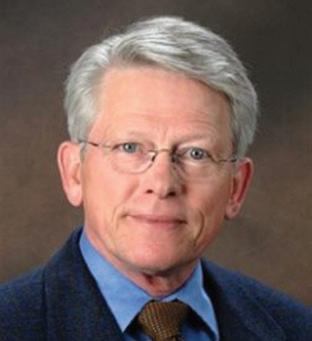

The Howard family started Autobell in 1960. CEO Chuck Howard, left, now oversees about 90 units. Separately, Sam's Xpress owner Sami Nafisi has built a nearly 50-unit business since opening his first location in suburban Fort Mill, South Carolina in 2012.


Automatic car washes have exploded in popularity. In 1996, about 52% of consumers mostly washed their car at home, according to the International Car Wash Association. By 2023, that number had tumbled to 21%.




Commerce
Lee
e state's new Commerce secretary brings rural roots, lobbying experience and bipartisan instincts to his new role.
By Ray Gronberg
Commerce Secretary Lee Lilley’s fourth- oor o ce overlooks North Carolina’s legislative complex, which in an era of divided government seems tting given how he sees his job and his department’s.
e 41-year-old started his career in Democratic politics, but a six-year stint with McGuireWoods Consulting went a long way toward establishing the ethos he brings to Gov. Josh Stein’s cabinet.
Clients, he says, don’t like hearing the word no.
e challenge is “how to be a government or entity that gets to yes on questions that come to us, the complex problems that ultimately reach our level,” Lilley says.
e Department of Commerce’s mission, he says, is to help create the conditions for prosperity in the state. at can’t be done alone, so a big part of the job is making it easier for the public and private sectors to join hands and pitch in.
“We’ve got to think about how we serve as a convener, a supporter of partner agencies, local governments and others who are doing most of the work that goes on out there,” Lilley says.
Lilley grew up in Williamston, a town of about 5,200 people in Martin County, one of North Carolina’s poorest with median household income of about $47,000. His family has owned a farm machinery business there since the 1950s.
A er earning a bachelor’s degree in cultural studies at UNC Chapel Hill, he joined U.S. Rep. G.K. Butter eld’s sta in 2007, then became the Democratic congressman's Washington-based legislative director before leaving in 2012 to join McGuireWoods.
e Richmond, Virginia-based enterprise has about 1,000 lawyers in 14 states. He worked in the nation's capital on federal issues.
Lilley came back to North Carolina in 2017 to join Gov. Roy Cooper’s sta as director of legislative a airs.

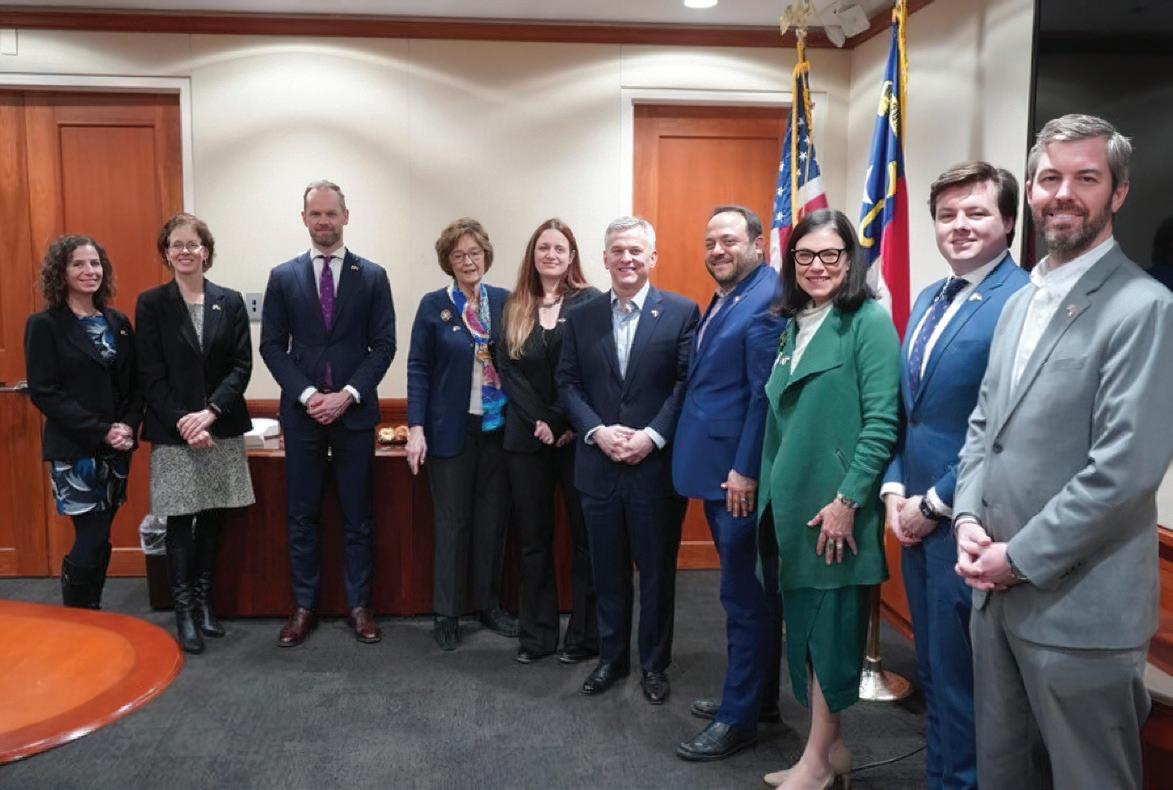

at’s not the typical track for an N.C. commerce secretary, who in recent decades tended to have backgrounds as backgrounds as corporate executives, attorneys or both.
But prior state-government service didn’t hurt. Only one of Lilley’s four most recent predecessors, Sharon Decker, came to the job without having worked for the state.
“At some point, anyone who is nominated to be the secretary of any agency, there is a political connection of some sort,” says Senate leader Phil Berger. “Some more than others.”
What counts, Berger adds, is having “somebody that’s going to do a good job, somebody that the governor has con dence in, somebody that’s going to represent the state well.” He thinks Lilley will “do all those things.”
At the governor’s o ce, Lilley eventually headed its pandemicrecovery team a er Cooper decided, in Lilley’s words, that he needed an in-house “throat to choke” in charge of the e ort. at experience should come in handy as the top priority of Gov. Stein and legislators is helping western North Carolina bounce back from Hurricane Helene.
e recovery e ort is “what we talk about rst” in every cabinet meeting and phone call, Lilley says. Stein has tasked Commerce with handling one of the most critical chunks of federal aid coming North Carolina’s way.
is is the $1.4 billion coming from the U.S. Department of Housing and Urban Development. It will be funding of last resort, most notably for housing repair and reconstruction.
Stein assigned that job to Commerce because the agency is already the state’s main point of contact, and because the Cooperera N.C. O ce of Recovery and Resiliency, by many assessments, botched the work following Hurricanes Matthew and Florence in the 2010s.
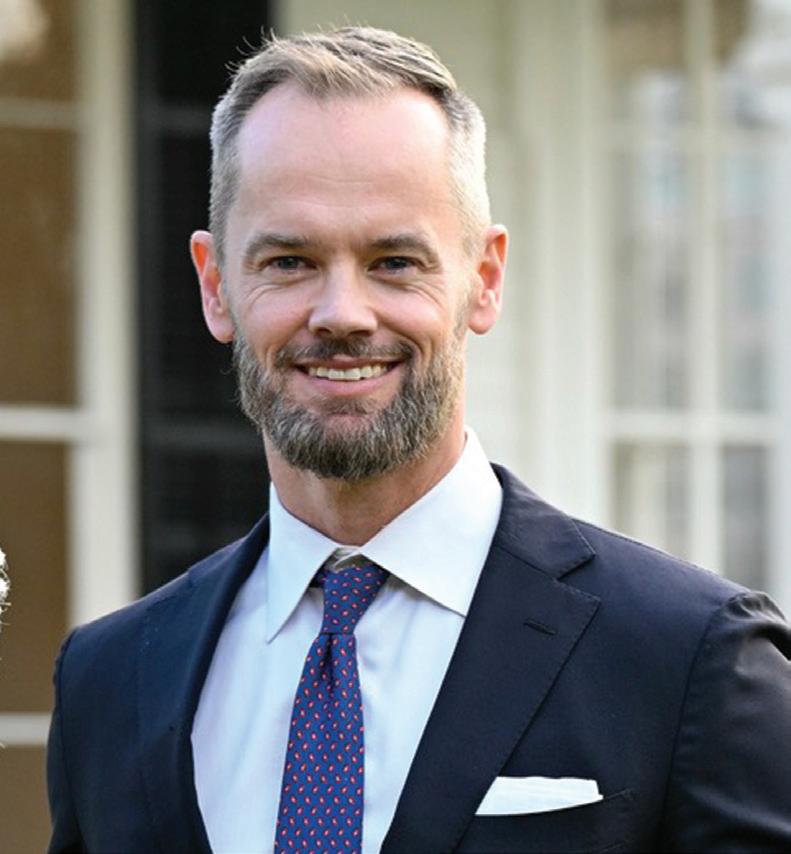


“I hope that Lee learned some things about what not to do from the Cooper administration, at least as it comes to storm relief, and that he’ll take those lessons and help us x the issue moving forward,” House Speaker Destin Hall says.
Lilley says those lessons include making sure it’s not the cause of delays in HUD’s release of the money. Commerce also needs to manage expectations and show transparency with the public and legislators, and rely more on vendors instead of in-house sta , providing the third-parties with the right incentives, he says.
When building homes, “we’re going to batch-assign projects” instead of bidding them out one-by-one, so contractors will “know how much they get paid every time.” eir success will determine “how many more projects they get to do, and thus how much money they get to make.”
As for Commerce’s mission, Lilley says Cooper’s secretaries, Tony Copeland and Machelle Baker Sanders, focused on improving the state’s business-recruiting “deal ow” and on workforce development, respectively.
Both concerns remain front and center, though industry recruitment is the key focus of the Economic Development Partnership of North Carolina, which split o from Commerce during Gov. Pat McCrory’s tenure.
Commerce and the state also have to focus on improving infrastructure and encouraging innovation, Lilley says.
Infrastructure issues enabled Virginia to edge North Carolina for the coveted No. 1 ranking in CNBC’s “Top States for Business” rankings last year. Cities and counties need “marketable real estate” to attract corporate investment, and one way to ensure they have it is to “break down walls” between state agencies, Lilley says.







Economic Development Partnership of North Carolina has driven the state’s business recruitment efforts for a decade. A public-private effort, its regional and local partnerships have found success from the coast to the mountains.
Economic Development Partnership of North Carolina was created in 2014, launching a publicprivate effort to lead the state’s business recruitment and development efforts. It has celebrated plenty of successes since, from Toyota’s $14 billion electric vehicle battery factory in Randolph County, which will create 5,100 jobs, to Pratt & Whitney’s $935 million turbine airfoil factory in Buncombe County that will employ 1,200 people. Count all the others, and EDPNC has had a hand in $67 billion in capital investment, 178,000 jobs and $10 billion in exports.
EDPNC Executive Director Chris Chung arrived in 2015 to helm the new organization, which was spun from N.C.


Department of Commerce. He was no stranger to EDPNC’s mission, previously serving a similar role in Missouri. But these waters were uncharted. “I think some people were doubtful that this new model would bring the purported advantages, and I’m proud that we’ve given them confidence that this was the right approach,” he says.
EDPNC’s funding has mostly come from the state. Chung says the private sector, including utilities, businesses, industries and staffing agencies, has contributed about $14 million. “All these private sector companies have provided money, because they believe not just in our mission of improving economic wellbeing for the state but in the way we are







approaching that mission,” he says. “And to me that’s a big vote of confidence.”

Support has come in other forms. Chung says EDPNC’s many partners include economic developers, communities, chambers of commerce and tourism boosters. All help push the partnership’s mission forward. “While the results are great, success also means how you hold yourself out as an organization and as a partner and as a resource to the different groups, whether that’s our local communities, elected officials or the business community,” he says. Together they’re creating and promoting economic opportunities across the state, from the mountains to the coast.





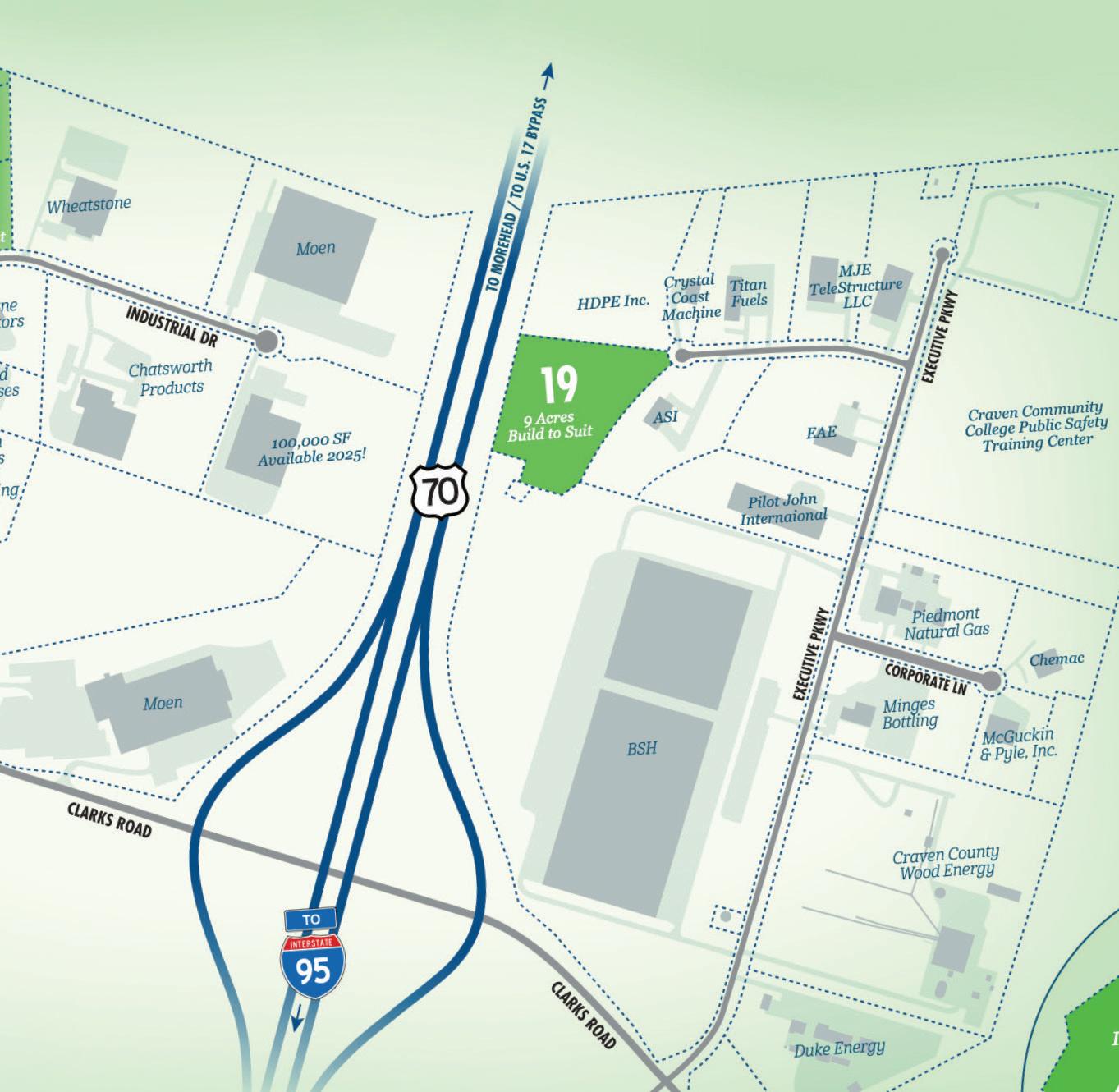








“It’s hard to predict the future, and that’s what makes economic development a fascinating business at times,”
■ Designed to meet new and expanding industry training needs
■ Staffed by Johnston Community College industry training experts
■ 68K SF including 8K of high bay space and 6K of classroom space
■ Directly on I-95 at exit 87, adjacent to the Four Oaks Business Park


– EDPNC Executive Director Christopher Chung




Last year was big for Wilson County. Five economic development projects were announced, and their investments totaled more than $2.7 billion, says Jennifer Lantz, Wilson Economic Development Council executive director. Topping the list was Johnson & Johnson, which is investing $2 billion in a factory that will make biologic medicines for oncology, immunology and neuroscience. Construction has started at Wilson County Corporate Park, she says.
Joining Johnson & Johnson is Reckitt Benckiser Health, which will make the over-the-counter drug Mucinex in Wilson. And Idexx Laboratories announced it will make veterinary test kits, SCHOTT Pharma will produce syringes and Neopac will expand its production of tubes, which have medical and cosmetic applications. The five announcements pledge to create more than 1,400 jobs.
The announcements are the fruits from years of labor by city and county officials. “We’ve been working for decades to provide the right infrastructure, not just roads and electricity and water and sewer but also fiber with our Greenlight system,” Lantz says. “Both the city and county have developed their own versions of rideshare programs called Ride and Arrive.”
Lantz says Wilson County counts more than 100 manufacturers. They represent a variety of industry sectors, though last year’s announcements were all within life sciences. “We already had a life sciences cluster here, and that helped attract these five companies to locate here or expand their footprint,” she says.






■ Raleigh-Durham | Benson, North Carolina
■ 501,215 SF industrial facility expandable up to 1,064,880 SF
■ Direct access to I-95 and I-40, as well as I-85, the industrial “backbone” of the Southeast
■ 30 Megawatts available power
■ Available immediately




■ Designed to meet new and expanding industry training needs
■ Staffed by Johnston Community College industry training experts
■ 68K SF including 8K of high bay space and 6K of classroom space
■ Directly on I-95 at exit 87, adjacent to the Four Oaks Business Park




Head west from Wilson County, and you’ll find Catawba County. Scott Millar is president of the county’s economic development corporation, and he’s seen ups and downs over the last three decades. While furniture and textile manufacturing has contracted since their heyday in the 1990s, some companies continue, including Hickorybased Sherrill’s Furniture, a familyowned manufacturer since 1945. “We had lost 45,000 jobs by 2002, when we thought our manufacturing base was rock solid,” he says. “We had to look toward diversification.”
Catawba has rebounded, with nearly 425 manufacturers, including auto-part makers and food processors.
Manufacturers employ more than 30% of the county’s workforce. Corning Optical and CommScope together employ more than 2,000 workers. Corning is the county’s second-largest employer, trailing only Catawba Valley Medical Center.
A growing concentration of data centers adds diversification, too. Apple started the movement in 2009, when it built one in Maiden. It has grown from a single server building to a 500,000-square-foot compound during the past 15 years. It brings more than jobs and notoriety. There’s tax dollars, too. “Apple has helped Maiden bring in money to build a new community center, new police and fire stations, and a new City Hall,” Millar says.
Apple announced it was investing $1 billion in North Carolina – including $448 million at its Maiden data center – in 2021. It announced $500 billion worth of expansions in nine states, including North Carolina data centers, in February. Those will roll out over the next four years and focus on artificial intelligence, silicon engineering and workforce skills development. Analysts predict Apple’s total investment in North Carolina could exceed $5 billion over the next decade.
Microsoft entered the scene in 2022, when it announced it was investing at least $1 billion in Catawba County over 10 years for the phased development of four data centers, Millar says.
“We believe Microsoft’s investment will have a similar, if not more, impact on our county than Apple,” he says.

















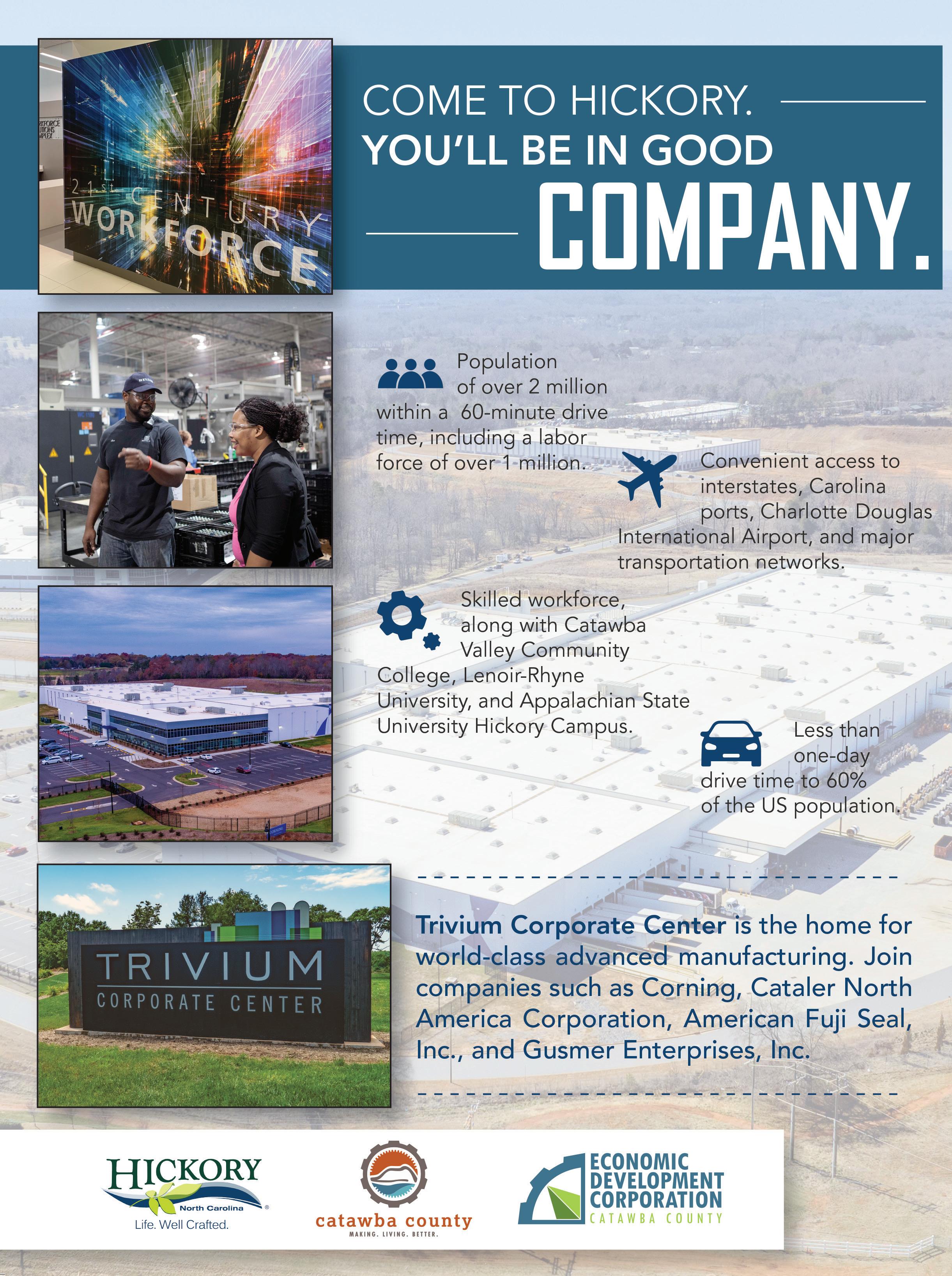
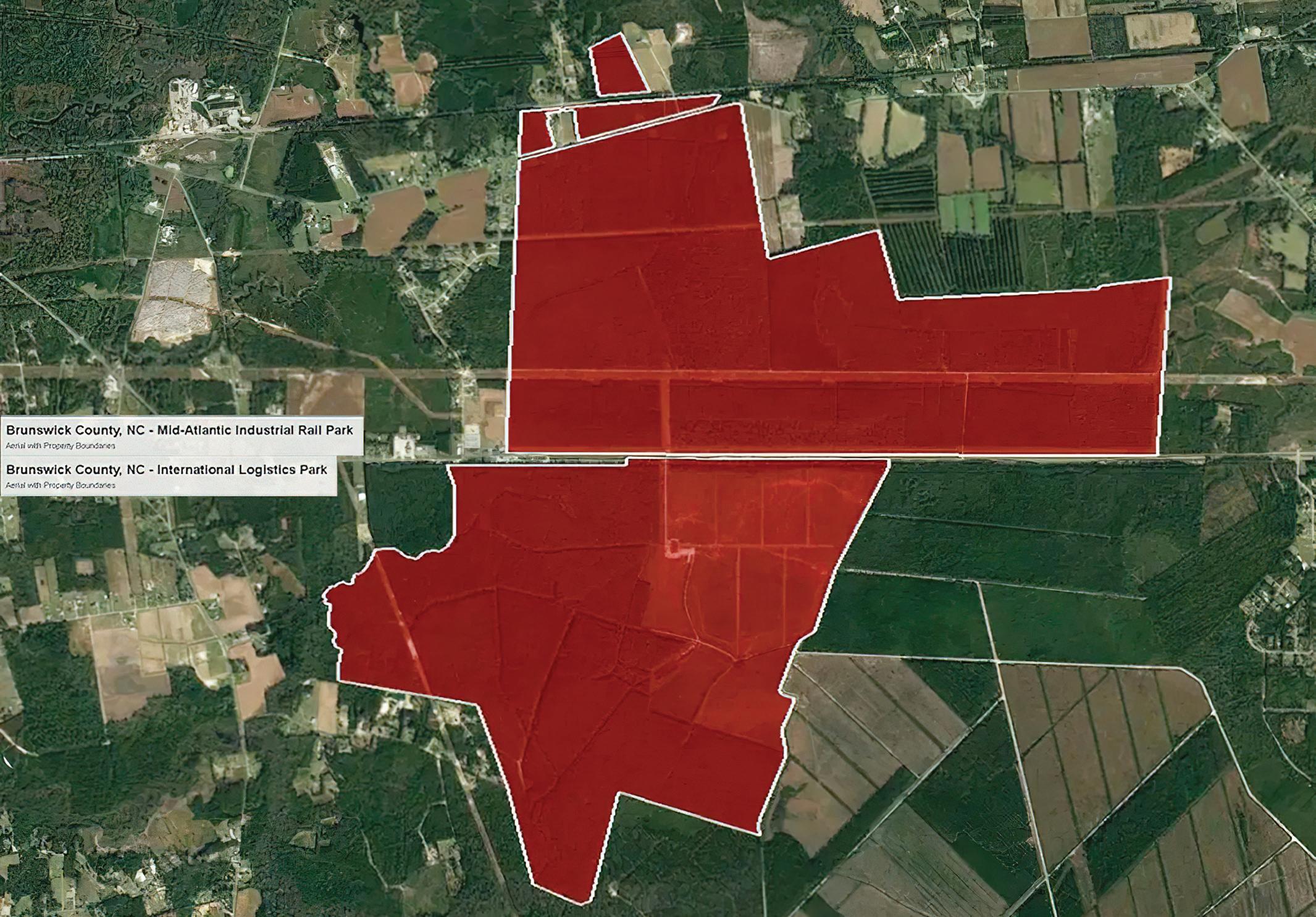
North Carolina’s Southeast Regional Economic Development Partnership represents 20 counties. “We cover a fifth of the state,” says Joe Melvin, its vice president. “Each county has its own economic development commission, and we work on their behalf.” The group celebrated its 30th anniversary last year. “In 1994, we were one of the original regional economic development commissions the General Assembly set up,” he says. “And 10 years ago, we transitioned to a public-private nonprofit organization.”
Small projects can make a big impact for North Carolina’s Southeast, whose focus is small cities and towns scattered
across a largely rural region. More than half of the region is economically distressed; N.C. Department of Commerce counts 11 Tier One counties.
“For some of our communities, quite honestly, a 40-job, $8 million project moves the needle pretty significantly,” Melvin says.
Melvin says recent job announcements have brought opportunity to the region. Five companies announced investments in Lumberton, Fayetteville, Wilmington and Raeford in February. They’ll create nearly 1,000 jobs. And more should be on the way. North Carolina’s Southeast received an appropriation of $5 million in 2021. It invited member counties to apply for project funding. He says each received $262,000 to identify sites, develop shell buildings and infrastructure
and perform due diligence. The money has been put to good use. “We’ve worked with them on 22 projects,” he says.
Two of North Carolina’s five megasites — International Logistics Park and Mid-Atlantic Industrial Rail Park — are in the region. The state’s Selectsite Readiness Program, completed about six months ago, identified other sites of 1,000 acres or less statewide. “As we’re thinking about our product development initiatives, we are leveraging and layering additional funding set aside for megasite and Selectsite programs,” Melvin says. “And our region is so diverse, we must be nimble in understanding the differences and the nuances of each of those communities and counties and help them achieve what is maximum value.”
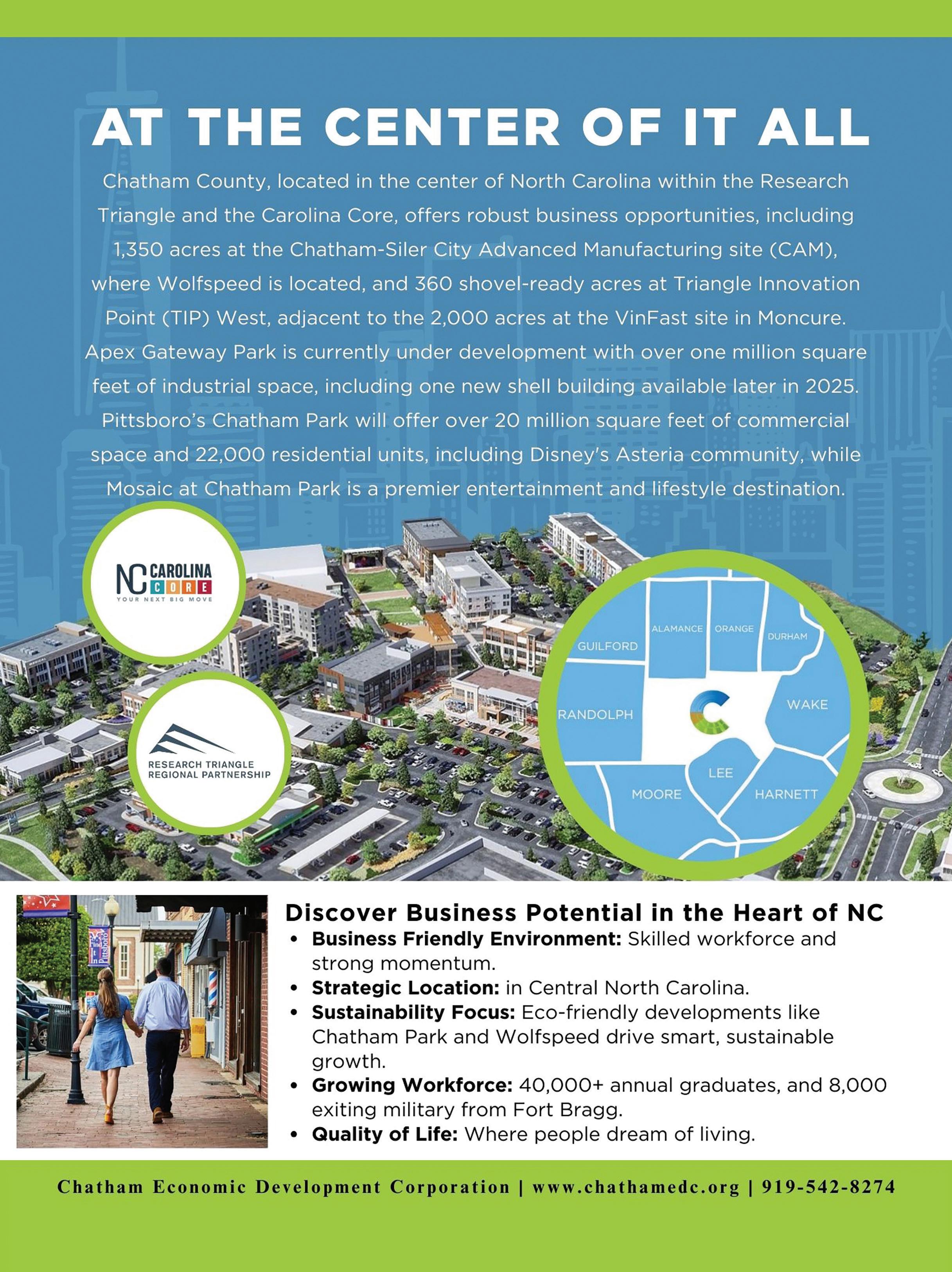
The vibrant economy in North Carolina, which business news channel CNBC ranked the top state for business in 2022 and 2023, and second in 2024, is ripe for new relocating and expanding businesses. But all that potential creates challenges, including a workforce shortage. U.S. Chamber of Commerce says there were only 55 available workers for each 100 available jobs in the state in 2023.
Wilson Community College is building a $30 million biologics training center. It’s scheduled to open next summer and help meet the workforce needs of last year’s announcements, including Johnson & Johnson. “That’s one piece of our long-term workforce preparedness strategy,” Lantz says. “A second piece is the BioWork program, developed by the North Carolina Biotechnology Center. And we partner with them on our life sciences projects.” BioWork, which teaches the technical skills needed for a
career in biopharma manufacturing, was added to the Wilson County high school curriculum this year.
The addition of high-wage jobs in Wilson County is expected to catch the attention of workers hungry for an income boost. “If you draw a big circle around Wilson, a 45-mile radius would attract workers seeking higher salaries for jobs in the life science sector,” Lantz says. “For other industries, that radius is probably about 30 miles.”
Millar says Catawba County attracts people because of its quality of life and “cool factor.” The county passed a $45 million matching bond referendum in 2014, funding miles of pedestrian and cycling trails along with housing units throughout Hickory. The county’s proximity to the mountains and big-city amenities in Charlotte attracts residents looking for a balanced lifestyle.
When it comes to workforce training, Catawba Valley Community College is leading the way. It has developed an academy approach to education
through its state-of-the-art Workforce Solutions Complex, where it teaches in demand advanced manufacturing and technology skills. Millar makes it the first stop on economic development tours of the county.
Melvin says filling job mandates in largely rural southeastern North Carolina can be challenging. “These mega projects sound great when you announce $1.2 billion in investment and 1,200 jobs,” he says. “But if we’re going to be real, there are many communities that can’t find 1,200 people to fill those jobs, and many can’t find people to fill 500 jobs. Many communities in the region max out at 100 or 150 jobs.”
Melvin cautions against attracting large projects that need so many employees that they cannibalize the local workforce. “It is a delicate dance for local economic developers to keep their current employment base staffed while furthering their mission of finding the next opportunity to add to the tax base,” he says.


Chung has served under three governors – Pat McCrory, Roy Cooper and Josh Stein – and three presidents – Barack Obama, Donald Trump and Joe Biden. He says it’s still too early to tell which direction Trump’s second term industrial policies will take. But any company that comes out of those industrial policies will need new locations, giving North Carolina targets to woo. “It’s hard to predict the future, and that’s what makes economic development a fascinating business at times,” he says. “There is no guarantee that tomorrow will look like today, and that’s what keeps us on our toes.”
While Chung acknowledges federal policy changes may create some
headwinds, he’s learned that North Carolina can adjust by localizing production and changing directions. “Does creating a tailwind balance or cancel the headwinds?” he says. “It’s hard to say, but as a rule, we have seen some of that upside potential in the past.”
Chung says the country focused on electric vehicles and clean energy through the Inflation Reduction Act over the last five years, and factories for the former and federal efforts for the latter happened in North Carolina. And he says there was a big bipartisan push for semiconductor funding, research and development through the CHIPS and Science Act of 2022. “That legislation drove a lot of activity by companies that needed to have a manufacturing
or production presence in the United States,” he says.
North Carolina’s future is bright, Chung says. While the new federal administration brings some uncertainty, the state is well-positioned to adjust in a changing environment. The state’s reputation boosts economic development efforts. “And I don’t take for granted a single dollar of what we have raised over the past 10 years, but at the same time, I know that those dollars represent a vote of confidence,” he says. “If we weren’t getting results or doing it in a way that fostered goodwill and a strong reputation, I don’t think we would be receiving that kind of financial support.” ■
— Teri Saylor is a freelance writer in Raleigh.


WE’RE CELEBRATING FAIR HOUSING MONTH
This April, join the 50,000 North Carolina REALTORS® in celebrating Fair Housing Month.
Fair Housing means everyone deserves a place to call home, regardless of race, color, national origin, religion, sex, familial status, or disability.
North Carolina REALTORS® are committed to Fair Housing for all North Carolinians ensuring that everyone has access to safe and affordable housing.
North Carolina REALTORS® receive specialized training to avoid discrimination and any practices that may foster it. The ethics and standards advocated by North Carolina REALTORS® ensure buyers and sellers are offered a marketplace that is free from discrimination and is based on the principles of private property rights – nothing else.
As REALTORS®, we believe that fairness is worth fighting for. Let’s work together to create communities where everyone can thrive.
